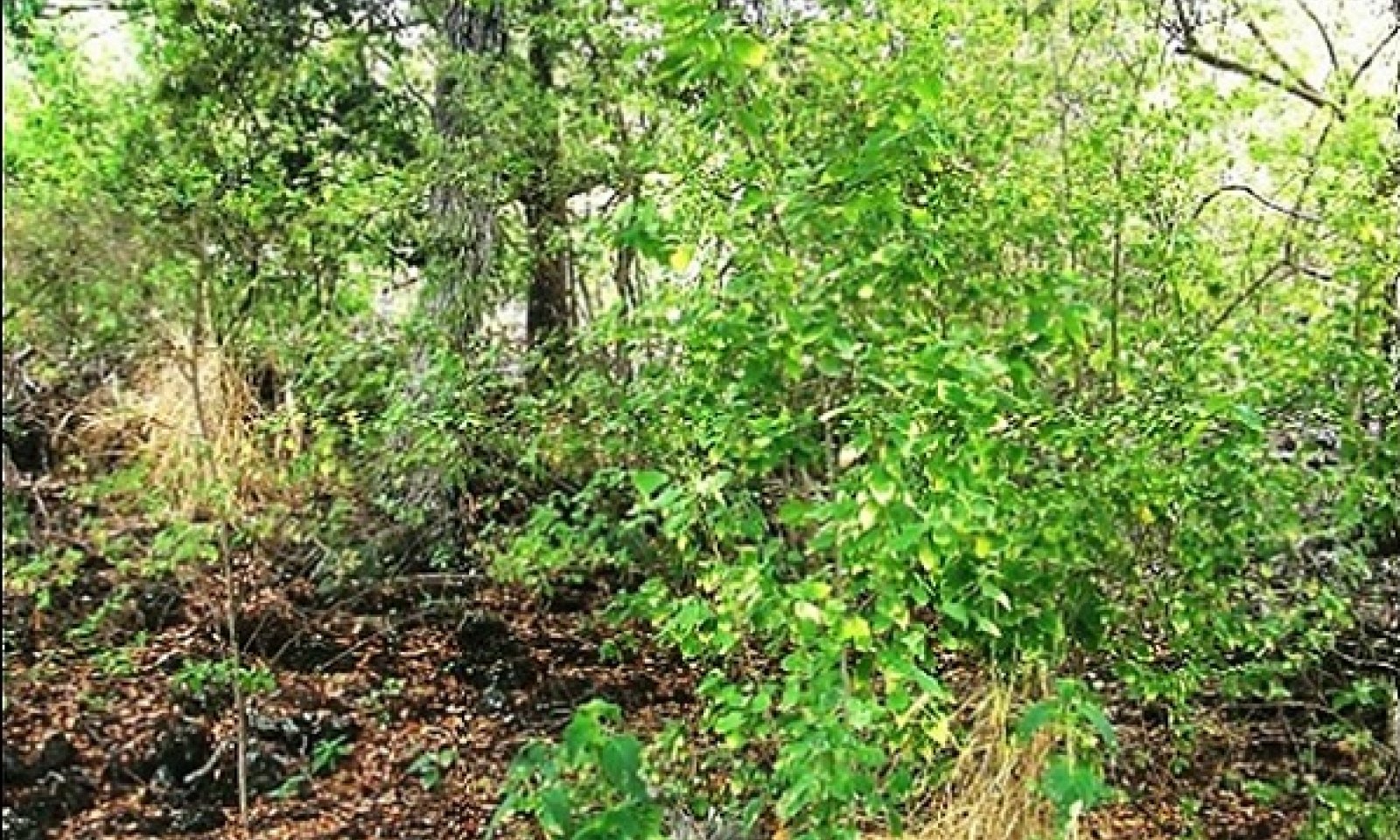

Natural Resources
Conservation Service
Ecological site VX161B01X500
Ustic Isothermic Forest
Accessed: 12/22/2025
General information
Provisional. A provisional ecological site description has undergone quality control and quality assurance review. It contains a working state and transition model and enough information to identify the ecological site.
MLRA notes
Major Land Resource Area (MLRA): 161B–Semiarid and Subhumid Organic Soils on Lava Flows
This MLRA occurs in the State of Hawaii in the Districts North and South Kona on the Big Island of Hawaii. This area is the leeward (western) side of the island on the slopes of Mauna Loa and Hualalai volcanoes. Elevation ranges from sea level to 6000 feet (about 2000 meters). Slopes follow the undulating to very steep topography of the lava flows. The flows are basaltic aa or pahoehoe lava, which are covered by a very shallow layer of organic material mixed with varying amounts of volcanic ash, although some places are covered only by volcanic ash. Climate ranges from dry to moist tropical. Average annual precipitation typically ranges from 30 to 80 inches (750 to 2000 millimeters), increasing with elevation. Rainfall occurs mostly in spring and summer. At higher elevations, frequent afternoon fog accumulation ameliorates evaporation and may add fog drip to the soil. Average annual air temperatures range from 55 to 75 degrees F (12 to 24 degrees C), with little seasonal variation. Dominant soils are Histosols and Andisols with isomesic to isohyperthermic soil temperature regimes. Very young lava flows may have no soil covering. Native vegetation changes as rainfall and fog increase with elevation. In the driest areas near sea level, sparse, low stature shrubs, grasses, and forbs predominate. Vegetation stature and density gradually increase with elevation to typical dry forest species such as lama, wiliwili, and alahee, transitional forest with olopua and papala kepau, rain forest with ohia lehua, koa, and hapuu, cool dry forest with koa, mamani, and mountain sandalwood, and finally cool dry shrublands that extend up to the highest unvegetated lava flows.
Classification relationships
This ecological site occurs within Major Land Resource Area (MLRA) 161B - Semiarid and Subhumid Organic Soils on Lava Flows.
Ecological site concept
This ecological site is the "dry forest" that occurs on the north-facing slopes of Hualalai and on the narrow Mauna Loa lava flows that are between Puuanahulu and the western flows of Mauna Kea. It is accessible from the upper highway that runs from Kona to mauka of Waikoloa Village (and continues to Waimea through another ecological site). Most of the area is on lands owned by the State of Hawaii and by Kamehameha Schools, with lesser areas on private land. Much of the fountaingrass-dominated area visible from Highway 190 between Kona and Waikoloa Road is in this ecological site.
The central concept of the Ustic Isothermic Forest is of well drained, very shallow to shallow soils formed in deposits of volcanic ash, highly decomposed plant material, or a combination of the two, and ranging from 1,500 to 10,000 years old. Annual air temperatures and rainfall create warm to cool (isothermic to isomesic), seasonally dry (ustic) soil conditions. These soils support a dry tropical forest with very high species diversity. The low to medium stature (25 to 60 feet; 8 to 18 meters) upper canopy is dominated by ohia lehua (Metrosideros polymorpha) on younger lava flows and by lama (Diospyros sandwicensis) on older lava flows. The lower levels of the plant community contain many small tree, shrub, vine, fern, grass, and sedge species.
Associated sites
| VX161B01X503 |
Ustic Isomesic Forest F161BY503 Ustic Isomesic Forest borders F161BY500 to the east at higher elevations. F161BY503 is cooler and moister than F161BY500 and supports tall stature forest dominated by koa. |
|---|
Similar sites
| VX161B01X501 |
Kona Weather Ustic Forest F161BY501 Kona Weather Ustic Forest occurs at lower elevations to the south of F161BY500. The two ecological sites share many plant species in common, but there are differences in the proportions of those species. |
|---|
Table 1. Dominant plant species
| Tree |
(1) Diospyros sandwicensis |
|---|---|
| Shrub |
Not specified |
| Herbaceous |
Not specified |
Legacy ID
F161BY500HI
Physiographic features
This ecological site occurs on lava flows on sloping mountainsides of shield volcanoes. Lava flows are aa (loose, cobbly) or pahoehoe (smooth, relatively unbroken).
Table 2. Representative physiographic features
| Landforms |
(1)
Shield volcano
(2) Lava flow |
|---|---|
| Flooding frequency | None |
| Ponding frequency | None |
| Elevation | 1,000 – 4,000 ft |
| Slope | 2 – 70% |
| Water table depth | 60 in |
| Aspect | NE, W, NW |
Climatic features
Air temperature in Hawaii is buffered by the surrounding ocean so that the range in temperature through the year is narrow. This creates “iso-“soil temperature regimes in which mean summer and winter temperatures differ by less than 6 degrees C (11 degrees F).
Hawaii lies within the trade wind zone. Significant amounts of moisture are picked up from the ocean by trade winds. As the trade winds from the northeast are forced up the mountains of the island their moisture condenses, creating rain on the windward slopes; the leeward side of the island receives little of this moisture. Some trade wind moisture is carried through the saddle between Mauna Kea and Kohala volcanoes to reach parts of this ecological site.
On this leeward side of the island, particularly on the slopes of Hualalai and Kohala, a “Kona weather pattern” exists. Heating of the land during the day pulls moist ocean air up the mountain slopes that produces clouds and rain in the afternoon. A cool breeze moves down the slopes at night. This weather pattern is strongest during the summer, creating a summer seasonal rainfall maximum.
In winter, low pressure systems often approach the island from the west, producing extensive rainstorms that primarily affect the leeward sides of the island.
Average annual precipitation ranges from 20 to 40 inches (500 to 1000 millimeters). Most precipitation occurs from January through July. Average annual temperature ranges from 54 to 68 degrees F (12 to 20 degrees C).
Table 3. Representative climatic features
| Frost-free period (average) | 365 days |
|---|---|
| Freeze-free period (average) | 365 days |
| Precipitation total (average) | 30 in |
Figure 1. Annual precipitation pattern
Figure 2. Annual average temperature pattern
Influencing water features
There are no water features influencing this ecological site.
Soil features
The volcanic ash soils of the Island of Hawaii are derived mostly from basaltic ash that varies relatively little in chemical composition (Hazlett and Hyndman 1996; Vitousek 2004). Most of these volcanic ash soils are classified as Andisols, which have these general management characteristics: ion exchange capacity that varies with pH, but mostly retaining anions such as nitrate; high phosphorus adsorption, which restricts phosphorus availability to plants; excellent physical properties (low bulk density, good friability, weak stickiness, stable soil aggregates) for cultivation, seedling emergence, and plant root growth; resistance to compaction and an ability to recover from compaction following repeated cycles of wetting and drying; and high capacity to hold water that is available to plants. These characteristics are due to the properties of the parent material, the clay-size noncrystalline materials formed by weathering, and the soil organic matter accumulated during soil formation (Shoji et al. 1993).
Andisols formed on pahoehoe lava can be very shallow to very deep. Pahoehoe is referred to as a “lithic contact,” which is a boundary between soil and underlying material that is coherent, continuous, difficult to dig with a spade, and contains few cracks that can be penetrated by roots (Soil Survey Staff 1999). Pahoehoe is typically very limiting to root penetration due to the spacing and size of cracks. However, this characteristic of pahoehoe is variable, and there are many instances of stands of large trees growing on very shallow and shallow ash soils over pahoehoe.
The lava rock fragments that constitute aa range in size from gravel (up to 3 inches or 2 to 76 millimeters) to stones (10 to 25 inches or 250 to 600 millimeters), but are primarily gravel and cobbles (3 to 10 inches or 76 to 250 millimeters). Below the layer of rock fragments is massive lava called “bluerock.” The interstices between rock fragments of Andisols formed in aa are filled with soil from the surface to the blue rock at the bottom of the soil. Some Andisols in aa have few or no rock fragments in the upper horizons, while others may have large amounts of rock fragments in all horizons and on the soil surface.
Soils that are moderately deep (20 to 40 inches or 50 to 100 centimeters) or deeper over underlying lava appear to present few or no limits native plants, naturalized grassland, or weedy vegetation, and it seems to make no difference whether the lava rock is pahoehoe or aa. However, these soils may present some tillage difficulties when formed in aa and containing significant amounts of coarse rock fragments near the surface. Very shallow and shallow ash soils over pahoehoe are sometimes ripped to break up the underlying lava and create a deeper rooting zone.
The organic soils of the Island of Hawaii are classified as Histosols. They were formed mainly in organic material consisting of highly decomposed leaves, twigs, and wood with small amounts of basic volcanic ash, cinders, and weathered lava; this is called highly decomposed parent material. Some of these soils contain slightly or moderately decomposed parent material, especially at or near the soil surface.
For organic soils that contain adequately high amounts of organic carbon (see Soil Survey Staff 1999) and are saturated with water less than 30 days per year in a normal year, the material is referred to as litter or an O horizon (Soil Survey Staff 1999).
All of the Histosols on the Big Island are classified as “euic,” which means they have relatively high base saturation as indicated by a pH of 4.5 or higher. Most Big Island Histosols have pH well above this minimum.
Histosols on pahoehoe lava tend to be shallow (less than 20 inches or 50 centimeters) or very shallow (less than 10 inches or 25 centimeters). Pahoehoe is referred to as a “lithic contact,” which is a boundary between soil and underlying material that is coherent, continuous, difficult to dig with a spade, and contains few cracks that can be penetrated by roots (Soil Survey Staff 1999). Pahoehoe is typically very limiting to root penetration due to the spacing and size of cracks. However, this characteristic of pahoehoe is variable, and there are many instances of large trees growing on very shallow and shallow soils over pahoehoe. When depth of soil to pahoehoe is less than 7.2 inches (18 centimeters), the soil is referred to as “micro.”
The lava rock fragments that constitute aa range in size from gravel (up to 3 inches or 2 to 76 millimeters) to stones (10 to 25 inches or 250 to 600 millimeters), but are primarily gravel and cobbles (3 to 10 inches or 76 to 250 millimeters). Below the layer of rock fragments is massive lava called “bluerock.” The interstices between rock fragments of Histosols formed in aa are filled with soil material from the surface to a particular depth, often moderately deep (20 to 40 inches or 50 to 100 centimeters), but sometimes shallower or deeper depending on the soil series. Between this soil material-filled horizon and the bluerock the interstices contain little or no soil material. However, live roots are often present in this horizon. These soils often support dense forests with large trees despite their unusual conformation. In order to observe the natural state of the soil, one must carefully disassemble the lava rock fragments so as not to allow the soil materials to fall into the gaps below.
Ripping and crushing lava by heavy machinery transforms these organic soils into Arents, which basically means sandy (the “Ar” or arenic; think of a sandy arena) soils with little or no natural horizon development (the “ents” or Entisols). Ripping pahoehoe lava eliminates the root-limiting layer of the lava. Crushing of ripped pahoehoe fragments or aa reduces the size of the fragments and the gaps between them and creates some finer, sand-sized particles. As much as 50% of the original organic matter can be lost in this process due to oxidation, but the resulting Arents are more suitable for agricultural operations. Arents are very susceptible to weed invasion, but there are apparently successful attempts at restoration of native plant species on these soils.
Soils in this ecological site are either mineral soils formed from volcanic ash deposited over lava or organic soils formed from highly decomposed plant materials accumulated from plants growing on lava rock. Many of the organic soils contain significant amounts of ash and are near the classification boundary (20% organic carbon by weight) between mineral and organic soils. All soils are cobbly to extremely cobbly. Organic soils are either shallow (10-20 inches or 25 to 50 centimeters to bedrock) in aa or very shallow (2-10 inches or 5 to 25 centimeters to bedrock) over pahoehoe. Mineral soils are shallow medial silt loams over pahoehoe or moderately deep (20-40 inches or 50 to 100 centimeters to bedrock) medial silt loams in aa. Soils in intact lama forests often have a distinctive brown organic layer on the surface. Soil temperature regimes range from isothermic to isomesic. Soil moisture regimes are ustic (in most years, dry for more than 90 cumulative days but less than 180 days).
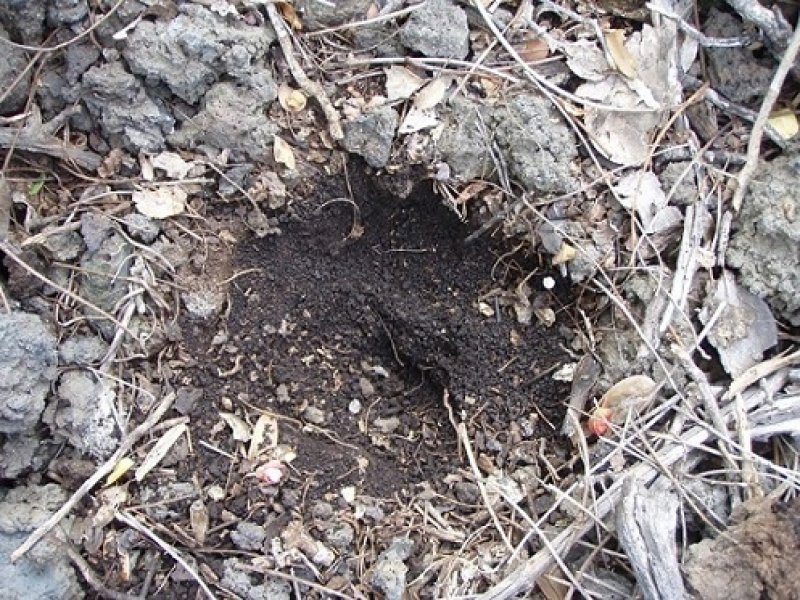
Figure 3. Napuu soil. 2/26/09 Clausnitzer MU156
Table 4. Representative soil features
| Surface texture |
(1) Medial (2) Medial Highly decomposed plant material |
|---|---|
| Drainage class | Well drained |
| Permeability class | Very slow to rapid |
| Soil depth | 2 – 40 in |
| Surface fragment cover <=3" | 2 – 40% |
| Surface fragment cover >3" | 15 – 70% |
| Available water capacity (0-40in) |
1 – 2 in |
| Calcium carbonate equivalent (0-40in) |
5% |
| Electrical conductivity (0-40in) |
2 mmhos/cm |
| Sodium adsorption ratio (0-40in) |
Not specified |
| Soil reaction (1:1 water) (0-40in) |
5.1 – 7.8 |
| Subsurface fragment volume <=3" (Depth not specified) |
2 – 70% |
| Subsurface fragment volume >3" (Depth not specified) |
15 – 50% |
Ecological dynamics
The information in this ecological site description (ESD), including the state-and-transition model (STM), was developed using archaeological and historical data, professional experience, and scientific studies. The information is representative of a complex set of plant communities. Not all scenarios or plants are included. Key indicator plants, animals, and ecological processes are described to inform land management decisions.
States and community phases within this ecological site were differentiated by inspection of data; ordination programs were not available. They were verified by professional consensus and consistent examples in the field.
Natural Disturbances
The natural (not human-caused) disturbances most important for discussion in this ecological site are lava flows, natural fires, and volcanic ash falls.
A lava flow obviously destroys all the vegetation it covers. Flows on this ecological site range from 1500 to 10,000 years old, a sufficient length of time for development of soils that support the typical vegetation. Younger, still unvegetated flows from Mauna Loa have cut across this ecological site and may do so again. To some extent, lava flows may start wildfires, but this is not a frequent occurrence. Wildfires started by lightning may occur occasionally.
Vegetation can be killed by erupted layers of ash from volcanic vents, depending on the temperature of the ash and the depth of accumulation. However, vegetation sometimes survives ash flows (Vitousek 2004). Vegetation rapidly recovers because ash flow deposits possess physical and chemical properties favorable to plant growth, including high water holding capacity, high surface area, rapid weathering, and favorable mineral nutrient content. New soils develop very rapidly in ash deposits, and further soil development is facilitated in turn by the rapidly-developing vegetation (Shoji et al. 1993). Future ash falls may occur here; past ash flows are old enough for soils and vegetation to have developed.
Human Disturbances
Human-related disturbances have been much more important than natural disturbances in this ecological site since the arrival of Polynesians and, later, Europeans. This is reflected in the State and Transition Model Diagram.
Humans arrived in the Hawaiian Islands 1200 to 1500 years ago. Their population gradually increased so that by 1600 AD at least 80% of all the lands in Hawaii below about 1500 feet (roughly 500 meters) in elevation had been extensively altered by humans (Kirch 1982); some pollen core data suggest that up to 100% of lowlands may have been altered (Athens 1997). By the time of European contact late in the 18th century, the Polynesians had developed high population densities and placed extensive areas under intensive agriculture (Cuddihy and Stone 1990). Prehistoric native lowland forest disturbance can be attributed to clearing for agriculture by hand or by fire, introduction of new plants, diseases, and animals, and wood harvesting (Athens 1997). Parts of this ecological site occur at elevations below 1500 feet or near parts of Kona that supported high human populations and intensive agriculture.
After the arrival of Europeans, documentary evidence attests to accelerated and extensive deforestation, erosion, siltation, and changes in local weather patterns (Kirch 1983) due to more intensive land use, modern tools, and introduction of more plant, animal, and microbe species.
The Polynesians introduced dogs, Pacific rats, and small pigs to the islands. Cattle, sheep, horses, goats, and larger European pigs were introduced in the final decades of the 18th century. These animals ranged free on the islands, becoming very numerous and destructive by the early decades of the 19th century. By 1851, records reported severe overstocking of pastures, lack of fences, and large numbers of feral livestock (Henke 1929).
Through the 20th and into the 21st centuries, increases in human populations with attendant land development, as well as accelerated introduction of non-native mammals, birds, reptiles, amphibians, invertebrates, plants, and microorganisms, have brought about dramatic changes to wild ecosystems in Hawaii. This ecological site evolved without the presence of large mammals or the regular occurrence of fires. Most, and probably all, of the native reference community phase is currently disturbed by humans or has been restored approximately within the past few decades.
Most of this ecological site is utilized by livestock. Originally, the animals were feral or semi-feral. Today, the area is fenced and managed primarily for cattle. Since its introduction in 1926 and rapid spread in the 1960s, crimson fountaingrass (Pennisetum setaceum) has come to dominate large areas. Fountaingrass provides good forage but is extremely susceptible to intense wildfires, which accounts for its continued dominance. Wildfires have destroyed much of the original native forest and continues to be a threat.
State and transition model
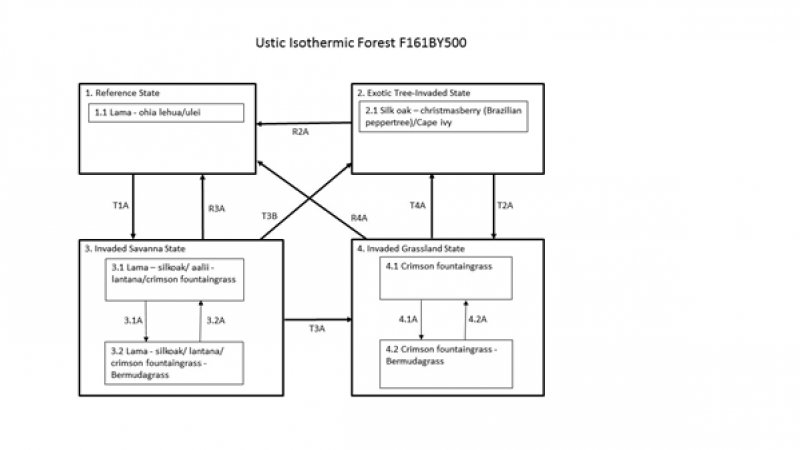
Figure 4. STM F161BY500
More interactive model formats are also available.
View Interactive Models
More interactive model formats are also available.
View Interactive Models
Click on state and transition labels to scroll to the respective text
State 1 submodel, plant communities
State 2 submodel, plant communities
State 3 submodel, plant communities
State 4 submodel, plant communities
State 1
Reference State
This state consists of one community phase. Intact examples of the original native plant community probably no longer exist. This description is compiled from field observations of restored and protected sites, remnant patches, and from historical accounts. In particular, the account of Joseph Rock (1913) was useful. The general appearance of this ecological site is an open to nearly closed canopy of low to medium height (25 to 60 feet or 8 to 18 meters) trees, a shrub understory, and a ground layer of vines and sedges. Standing wood volumes are currently in the range of 300-800-1500 (low- midrange-high) cubic feet per acre on most soils, and 100-300-500 cubic feet per acre on very shallow soils over pahoehoe. Some ohia stands may be as high as 2300 cubic feet per acre.
Community 1.1
Lama - `ohi`a lehua/ulei

Figure 5. Reference community phase. 5/24/06 D Clausnitzer MU158
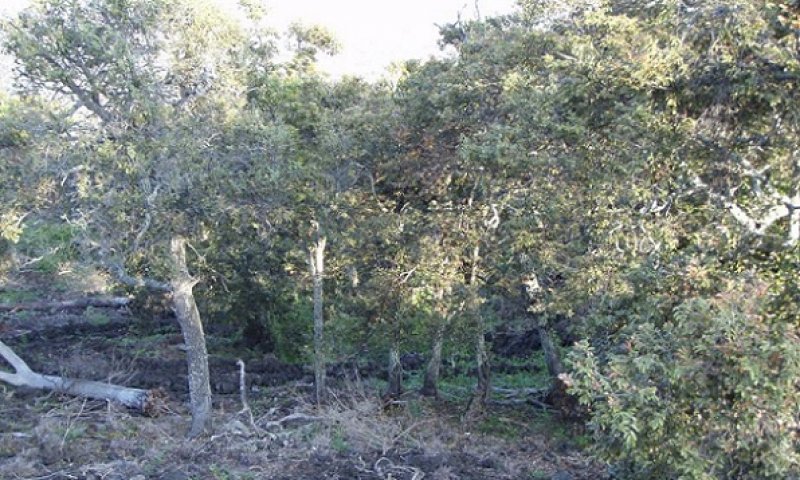
Figure 6. Reference community phase Kaupulehu. 2/26/09 D Clausnitzer generic photo
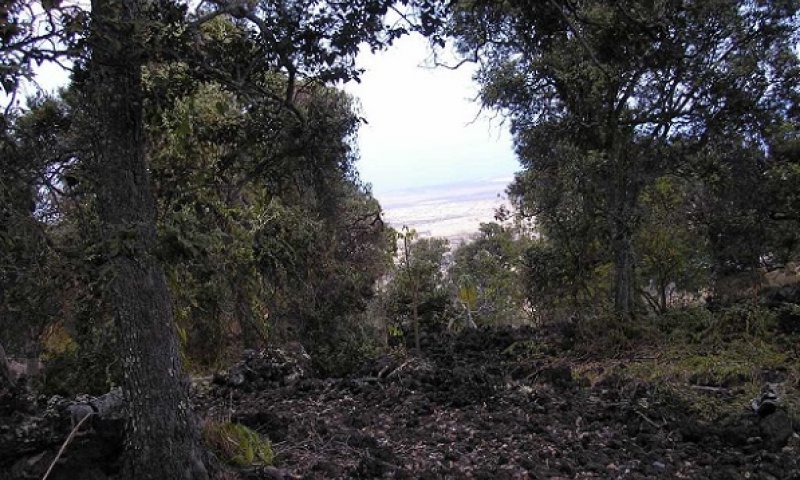
Figure 7. Reference community phase. 5/24/06 D Clausnitzer MU158
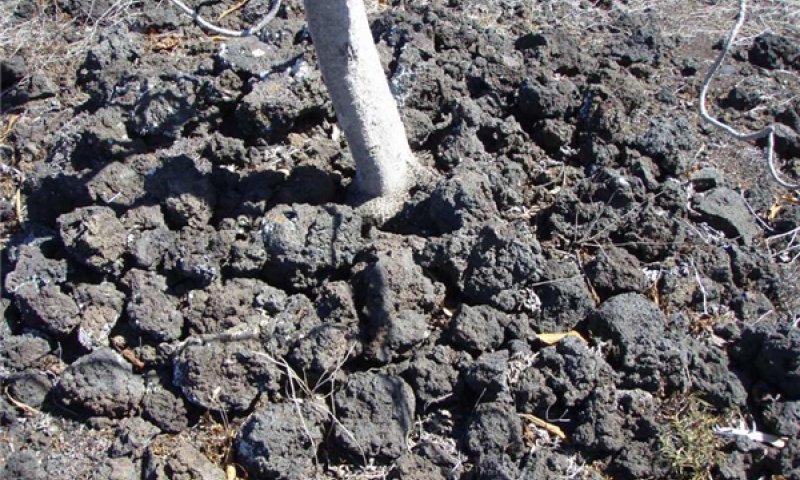
Figure 8. Kauila tree in extr cobbly soil. 2/26/09 D Clausnitzer generic photo
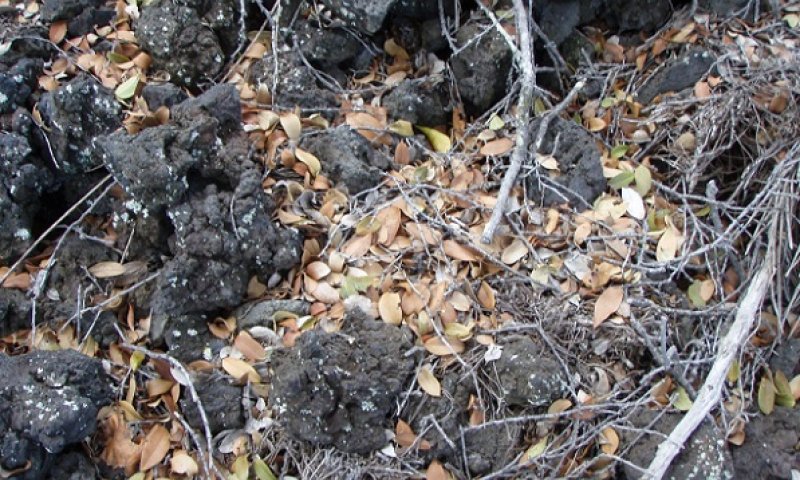
Figure 9. Litter on extr cobbly aa surface. 2/26/09 D Clausnitzer generic photo
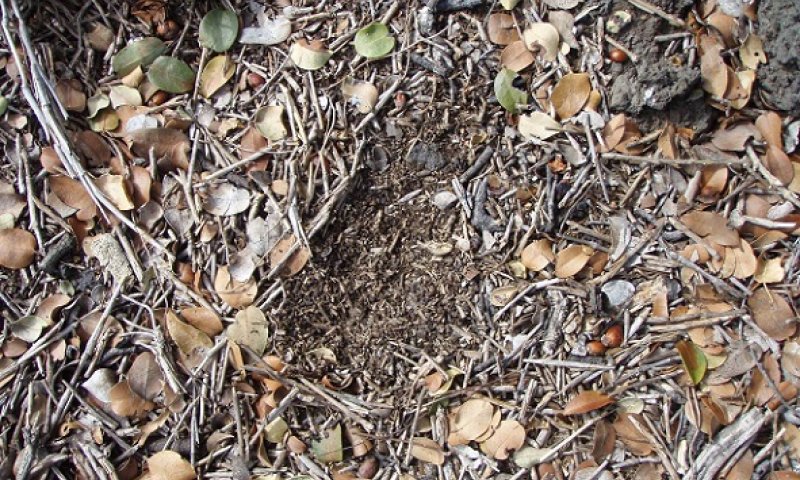
Figure 10. Decomposed litter below fresh litter. 2/26/09 D Clausnitzer generic photo
Three different tree canopy types appear to exist within this community phase. They are differentiated by underlying lava flow type (pahoehoe or aa), lava flow age, and soil depth. Within these types, some variation exists along the elevational temperature and moisture gradients (i.e., lower elevation is hotter and drier).
Forest overstory. The first subtype, found on younger aa flows, is dominated by ohia lehua, along with kolea or Lanai colicwood (Myrsine lanaiensis) and mountain sandalwood (Santalum paniculatum). Slightly older sites are dominated by lama (Diospyros sandwicensis) or by a diverse collection of species with kauila (Colubrina oppositifolia) as the most abundant species. Within this subtype, lama, ohia lehua, ohe makai (Reynoldsia sandwicensis), wiliwili (Erythrina sandwicense), and mountain sandalwood are the main species on drier, low elevation sites; moister, higher elevation sites originally would have contained those species within a more diverse array of species. The third subtype is on areas of very shallow soils on pahoehoe, which now support little more than fountaingrass. Remnant native tree stands suggest that these areas originally may have supported native forests of lower stature and plant cover than sites with deeper soils. Currently, very shallow pahoehoe sites produce less fountaingrass biomass than sites with deeper soils.
Mountain sandalwood was probably more common in the past, but much of it was harvested in the early 19th century.
Tree diversity is high; refer to the table below for a complete list.
Forest understory. Alahee (Psydrax odorata) is a common small tree. Halapepe (Pleomele hawaiiensis) formerly was common (Rock 1913) but is now rare. Previously “plentiful” (Rock 1913) but now rare and of smaller stature is uhiuhi (Caesalpinia kavaiensis). Some other tree species that are much less common than a century ago are akoko (Chamaesyce olowaluana), kawau (Zanthoxylum spp.), ohe makai (Reynoldsia sandwicensis), aiea (Nothocestrum breviflorum), kuahiwi (Hibiscadelphus hualalaiensis), kokia (Kokia drynarioides), and mao hau hele (Hibiscus brackenridgei).
The ground level understory is sparse, containing (or formerly containing) nehe (Lipochaeta spp.), hue hue (Cocculus orbiculatus), anunu (Sicyos anunu), and a small-leaf variety of maile (Alyxia stellata). Aweoweo (Chenopodium oahuense) is a common shrub that formerly grew to the size of a small tree (Rock 1913).
Table 5. Soil surface cover
| Tree basal cover | 1-2% |
|---|---|
| Shrub/vine/liana basal cover | 1-2% |
| Grass/grasslike basal cover | 0% |
| Forb basal cover | 0.0-0.2% |
| Non-vascular plants | 0% |
| Biological crusts | 0% |
| Litter | 50-70% |
| Surface fragments >0.25" and <=3" | 5-30% |
| Surface fragments >3" | 5-30% |
| Bedrock | 0% |
| Water | 0% |
| Bare ground | 1-2% |
Table 6. Woody ground cover
| Downed wood, fine-small (<0.40" diameter; 1-hour fuels) | – |
|---|---|
| Downed wood, fine-medium (0.40-0.99" diameter; 10-hour fuels) | – |
| Downed wood, fine-large (1.00-2.99" diameter; 100-hour fuels) | – |
| Downed wood, coarse-small (3.00-8.99" diameter; 1,000-hour fuels) | 0-1% |
| Downed wood, coarse-large (>9.00" diameter; 10,000-hour fuels) | 0% |
| Tree snags** (hard***) | – |
| Tree snags** (soft***) | – |
| Tree snag count** (hard***) | 1-2 per acre |
| Tree snag count** (hard***) | 1-2 per acre |
* Decomposition Classes: N - no or little integration with the soil surface; I - partial to nearly full integration with the soil surface.
** >10.16cm diameter at 1.3716m above ground and >1.8288m height--if less diameter OR height use applicable down wood type; for pinyon and juniper, use 0.3048m above ground.
*** Hard - tree is dead with most or all of bark intact; Soft - most of bark has sloughed off.
Table 7. Canopy structure (% cover)
| Height Above Ground (ft) | Tree | Shrub/Vine | Grass/ Grasslike |
Forb |
|---|---|---|---|---|
| <0.5 | 0% | 0-1% | 0% | 0% |
| >0.5 <= 1 | 0% | 0% | 0-1% | 0% |
| >1 <= 2 | 0-1% | 1-1% | 1-1% | 1-1% |
| >2 <= 4.5 | 1-1% | 1-1% | – | – |
| >4.5 <= 13 | 5-10% | 10-15% | – | – |
| >13 <= 40 | 20-30% | 5-10% | – | – |
| >40 <= 80 | 20-25% | – | – | – |
| >80 <= 120 | – | – | – | – |
| >120 | – | – | – | – |
State 2
Exotic Tree-Invaded State
This state consists of one community phase. It may represent a successional endpoint, in that most plant species appear to be unable to survive in the understory and because it may eventually become partially resistant to the occurrence of stand-destroying wildfires.
Community 2.1
Silk oak - Brazilian peppertree (christmasberry)/capeivy
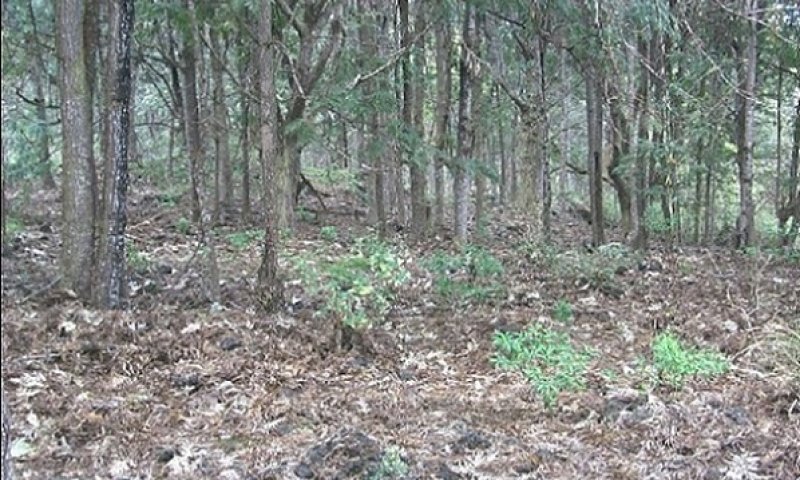
Figure 11. Silkoak stand with heavy litter layer. 4/20/07 D Clausnitzer generic photo
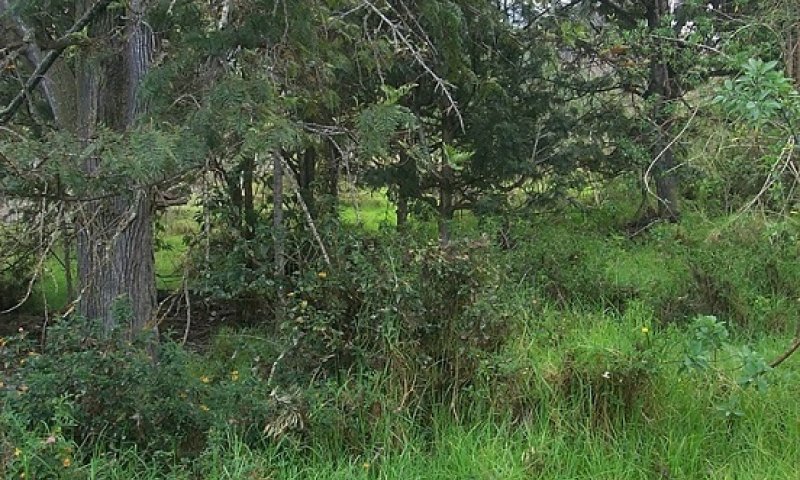
Figure 12. Kikuyugrass and lantana under open silk oak canopy. 4/20/07 Clausnitzer generic photo
This phase appears to occur mostly in the moister, higher elevation half of this ecological site. If this phase avoids fire long enough for the canopy to close and trees to grow tall, a monotypic stand of introduced trees can develop that eliminates almost all understory plants.
Forest overstory. The most common invasive trees in this ecological site are silk oak (Grevillea robusta), christmasberry or Brazilian peppertree (Schinus terebinthifolius), jacaranda (Jacaranda mimosifolia), and peppertree (Schinus molle). Only silk oak and christmasberry show the ability to dominate the landscape. Christmasberry produces a dense, low-stature (20 to 30 feet or 6 to 9 meters) canopy that dominates the understory and inhibits regeneration and growth of most plants. Silk oak grows taller (to about 80 feet or 25 meters) and is able to emerge through both native tree and christmasberry canopies.
Forest understory. The only species that appears to attain any abundance is capeivy (Delairea odorata).
Table 8. Soil surface cover
| Tree basal cover | 4-5% |
|---|---|
| Shrub/vine/liana basal cover | 0.1-0.5% |
| Grass/grasslike basal cover | 0% |
| Forb basal cover | 0% |
| Non-vascular plants | 0.5-1.0% |
| Biological crusts | 0% |
| Litter | 85-90% |
| Surface fragments >0.25" and <=3" | 0-1% |
| Surface fragments >3" | 0-1% |
| Bedrock | 0% |
| Water | 0% |
| Bare ground | 3-5% |
Table 9. Woody ground cover
| Downed wood, fine-small (<0.40" diameter; 1-hour fuels) | – |
|---|---|
| Downed wood, fine-medium (0.40-0.99" diameter; 10-hour fuels) | – |
| Downed wood, fine-large (1.00-2.99" diameter; 100-hour fuels) | – |
| Downed wood, coarse-small (3.00-8.99" diameter; 1,000-hour fuels) | 1-1% |
| Downed wood, coarse-large (>9.00" diameter; 10,000-hour fuels) | 0-0% |
| Tree snags** (hard***) | – |
| Tree snags** (soft***) | – |
| Tree snag count** (hard***) | |
| Tree snag count** (hard***) |
* Decomposition Classes: N - no or little integration with the soil surface; I - partial to nearly full integration with the soil surface.
** >10.16cm diameter at 1.3716m above ground and >1.8288m height--if less diameter OR height use applicable down wood type; for pinyon and juniper, use 0.3048m above ground.
*** Hard - tree is dead with most or all of bark intact; Soft - most of bark has sloughed off.
Table 10. Canopy structure (% cover)
| Height Above Ground (ft) | Tree | Shrub/Vine | Grass/ Grasslike |
Forb |
|---|---|---|---|---|
| <0.5 | – | 20-50% | 0% | 0% |
| >0.5 <= 1 | – | – | 0-1% | 0-1% |
| >1 <= 2 | 0% | – | 0-1% | 0-1% |
| >2 <= 4.5 | 0% | – | – | – |
| >4.5 <= 13 | 0-1% | – | – | – |
| >13 <= 40 | 0-1% | – | – | – |
| >40 <= 80 | 85-90% | – | – | – |
| >80 <= 120 | – | – | – | – |
| >120 | – | – | – | – |
State 3
Invaded Savanna State
This state is comprised of two plant communities. The overstory in both plant communities consists of an open to moderately closed canopy of native trees, introduced trees, or a combination of both. The understory is dominated by crimson fountaingrass (Pennisetum setaceum), which was originally introduced to Hawaii in 1926 as an ornamental plant. This grass outcompetes most other plants for soil moisture and growing space. It burns readily and frequently, producing a fast-moving wall of flames over 20 feet tall that destroys all other vegetation. Fountaingrass stands recover quickly from these fires. The native shrub aalii (Dodonaea viscosa) can increase in fountaingrass stands when fire is absent for many years. Silk oak (Grevillea robusta), an introduced tree, apparently can reproduce in fountaingrass; native tree seedlings are found only rarely beneath fountaingrass cover. Fountaingrass grows very densely to about five feet tall. Under dense tree overstory canopy cover (80-90%), fountaingrass biomass is reduced somewhat (Jarrod Thaxton, person communication), but is still often dense enough to carry a fire. Fountaingrass is the main forage species for cattle. Under conditions of continuous grazing it will be replaced partially by short, less palatable grass species, weedy forbs, and shrubs. Although dense and even fairly diverse stands of native trees may give this state the appearance of an intact forest, native plant regeneration is very sparse due to weed competition, wildfire, and ungulate damage. This fact is illustrated by the lack of native tree seedlings and saplings or shrubs, vines, and forbs. Guineagrass (Urochloa maxima) is common along fence lines and in protected spots in this ecological site. This pasture grass grows well in similar soils and environments in South Kona, where fountaingrass is not yet widespread. It simply may not be competitive in the grazing and fire regimes associated with fountaingrass.
Community 3.1
Lama - silkoak/`a`ali`i - lantana/crimson fountaingrass
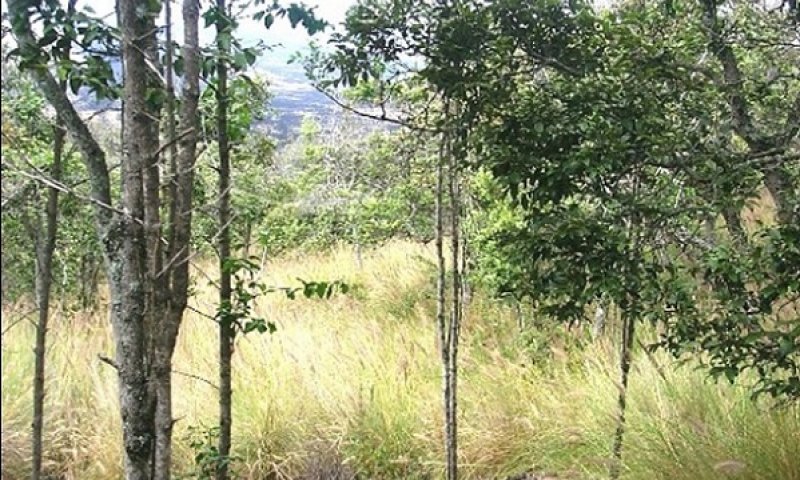
Figure 13. Native trees with fountaingrass. 5/24/06 D Clausnitzer MU158
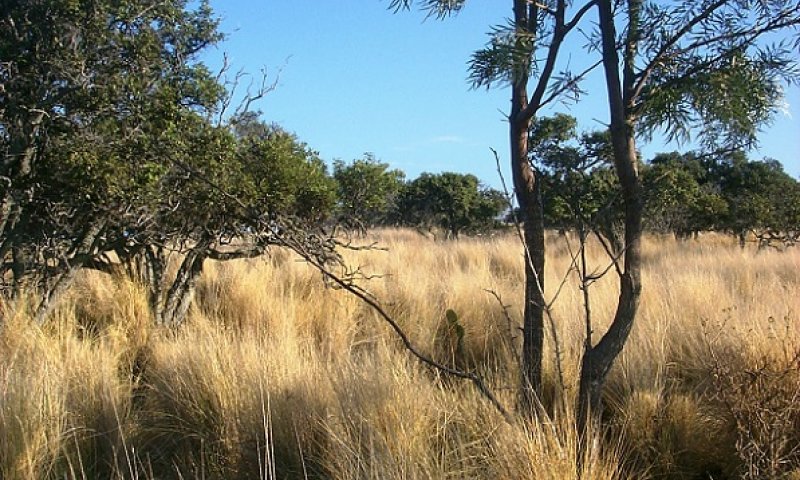
Figure 14. Lama and silk oak with fountaingrass. 1/20/06 D Clausnitzer generic photo
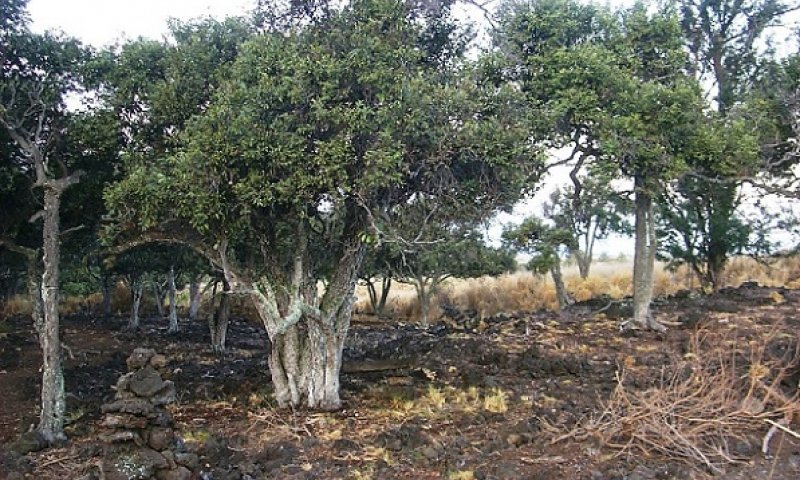
Figure 15. After fountaingrass removal. 1/20/06 D Clausnitzer MU332
This community phase consists of a variable canopy of native and/or introduced trees with a sparse understory of native and/or introduced shrubs. The soil surface is dominated by an almost continuous cover of fountaingrass up to 5 feet (1.5 meters) tall. Fountaingrass cover is less on young aa flows, areas of pahoehoe outcrop, and beneath dense tree cover. Few other plants are able to reproduce or grow in fountaingrass stands. Water use and rain interception by fountaingrass reduces soil moisture available to trees. This is illustrated by increased tree growth when fountaingrass is removed.
Forest overstory. The overstory is potentially very diverse, both in native and introduced species. Of native tree species, the most common are ohia lehua (Metrosideros polymorpha), lama (Diospyros sandwicensis), and kolea (Myrsine lanaiensis). The most common introduced tree species are silk oak (Grevillea robusta), christmasberry (Schinus terebinthifolius), peppertree (Schinus molle), and jacaranda (Jacaranda mimosifolia). Kukui (Aleurites moluccana) is abundant in some areas.
Forest understory. Of native shrubs, aalii (Dodonaea viscosa) and ulei (Osteomeles anthyllidifolia) are most common. Lantana (Lantana camara) and apple of sodom (Solanum linnaeanum) are the most common introduced shrubs. Glycine (Neonotonia wightii), an introduced leguminous vine, is potentially abundant but tends to be heavily grazed. Crimson fountaingrass (Pennisetum setaceum), an introduced warm season (C4) bunchgrass, is by far the dominant grass species.
Figure 16. Annual production by plant type (representative values) or group (midpoint values)
Community 3.2
Lama - silkoak/lantana/crimson fountaingrass - Bermudagrass
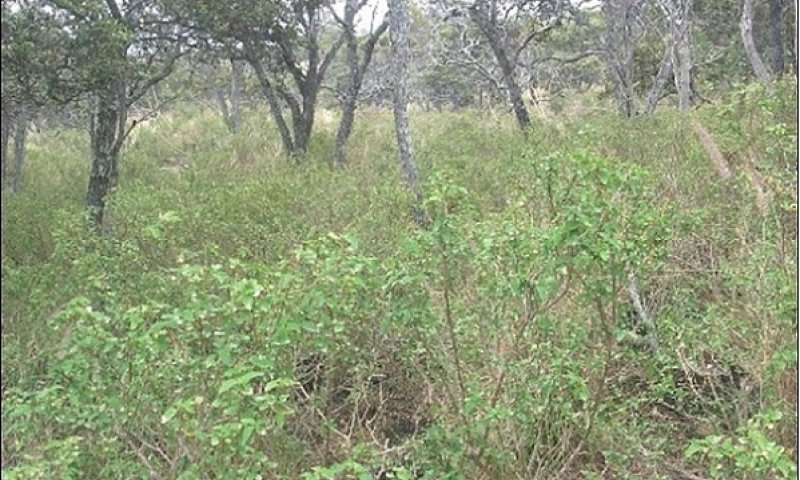
Figure 17. Heavy lantana infestation with native trees. 4/18/07 D Clausnitzer MU150
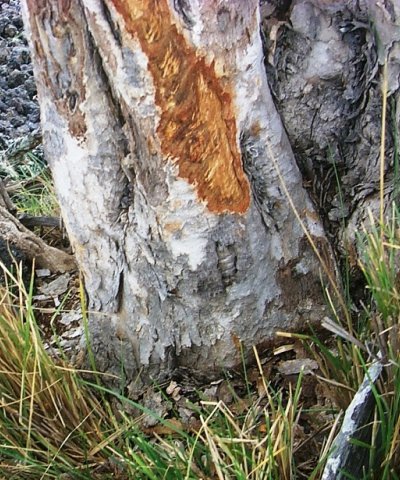
Figure 18. Ungulate damage to kauila tree. D Clausnitzer generic photo
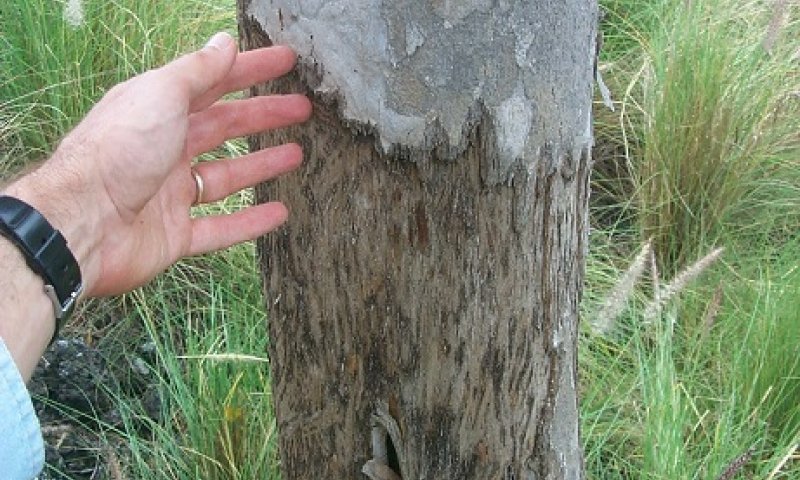
Figure 19. Ungulate damage to kauila tree. D Clausnitzer generic photo
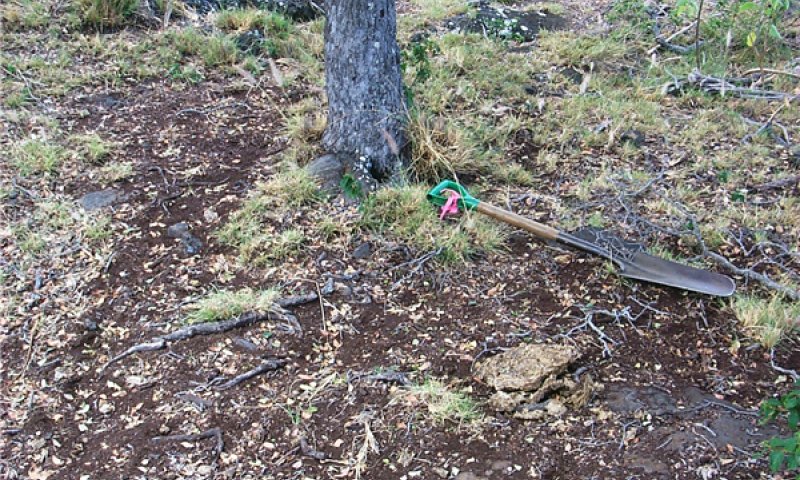
Figure 20. Lama tree in extremely shallow pahoehoe soil. Clausnitzer generic photo
This community phase consists of a variable canopy of native and/or introduced trees with a sparse understory of native and/or introduced shrubs. Grasses consist of a combination of crimson fountaingrass and shortgrass species such as Bermudagrass. Weedy shrubs and forbs can be abundant. Native plant regeneration is sparse to nonexistent due to heavy damage by ungulates.
Forest overstory. Introduced silk oak (Grevillea robusta) is the most abundant large tree species. Native lama (Diospyros sandwicensis) and ohia lehua (Metrosideros polymorpha) are common native species. Scattered individuals of other native tree species can occur.
Forest understory. Lantana (Lantana camara), an introduced shrub species, is the most common shrub. Crimson fountaingrass is still the most abundant grass, but Bermudagrass (Cynodon dactylon) and Natal redtop (Melinis repens) are more abundant than in phase 3.1.
Table 11. Soil surface cover
| Tree basal cover | 0.0-0.5% |
|---|---|
| Shrub/vine/liana basal cover | 0.0-0.2% |
| Grass/grasslike basal cover | 10-15% |
| Forb basal cover | 0.0-0.1% |
| Non-vascular plants | 0% |
| Biological crusts | 0% |
| Litter | 60-70% |
| Surface fragments >0.25" and <=3" | 3-5% |
| Surface fragments >3" | 3-5% |
| Bedrock | 0% |
| Water | 0% |
| Bare ground | 5-10% |
Table 12. Woody ground cover
| Downed wood, fine-small (<0.40" diameter; 1-hour fuels) | – |
|---|---|
| Downed wood, fine-medium (0.40-0.99" diameter; 10-hour fuels) | – |
| Downed wood, fine-large (1.00-2.99" diameter; 100-hour fuels) | – |
| Downed wood, coarse-small (3.00-8.99" diameter; 1,000-hour fuels) | – |
| Downed wood, coarse-large (>9.00" diameter; 10,000-hour fuels) | 0% |
| Tree snags** (hard***) | – |
| Tree snags** (soft***) | – |
| Tree snag count** (hard***) | 2-5 per acre |
| Tree snag count** (hard***) | 1-3 per acre |
* Decomposition Classes: N - no or little integration with the soil surface; I - partial to nearly full integration with the soil surface.
** >10.16cm diameter at 1.3716m above ground and >1.8288m height--if less diameter OR height use applicable down wood type; for pinyon and juniper, use 0.3048m above ground.
*** Hard - tree is dead with most or all of bark intact; Soft - most of bark has sloughed off.
Table 13. Canopy structure (% cover)
| Height Above Ground (ft) | Tree | Shrub/Vine | Grass/ Grasslike |
Forb |
|---|---|---|---|---|
| <0.5 | 0% | 0% | 0-1% | 2-3% |
| >0.5 <= 1 | 0% | 0-1% | 3-5% | 3-5% |
| >1 <= 2 | 0-1% | 1-1% | 60-65% | 3-5% |
| >2 <= 4.5 | 1-1% | 7-10% | 3-5% | 0-1% |
| >4.5 <= 13 | 1-2% | 0% | – | – |
| >13 <= 40 | 10-20% | – | – | – |
| >40 <= 80 | 0-5% | – | – | – |
| >80 <= 120 | – | – | – | – |
| >120 | – | – | – | – |
Pathway 3.1A
Community 3.1 to 3.2


Fountaingrass cover and vigor are reduced by continuous grazing. This allows shortgrass species such as Bermudagrass (Cynodon dactylon) to increase along with weedy shrubs and forbs.
Pathway 3.2A
Community 3.2 to 3.1


This community phase can change to phase 3.1 by application of a prescribed grazing program that allows fountaingrass to reassume dominance. Herbicidal weed control may be necessary if taller weedy forbs and/or shrubs are abundant.
State 4
Invaded Grassland State
This state consists of two community phases. It has an almost continuous cover of grass with no or very few trees, shrubs, and forbs. Grass cover is less on young aa flows and areas of pahoehoe outcrop. Few other plants are able to reproduce or survive in the grass stands. Wildfires are frequent, intense, and often of large extent. Most of the area occupied by this state was created originally by human-caused wildfires.
Community 4.1
Crimson fountaingrass
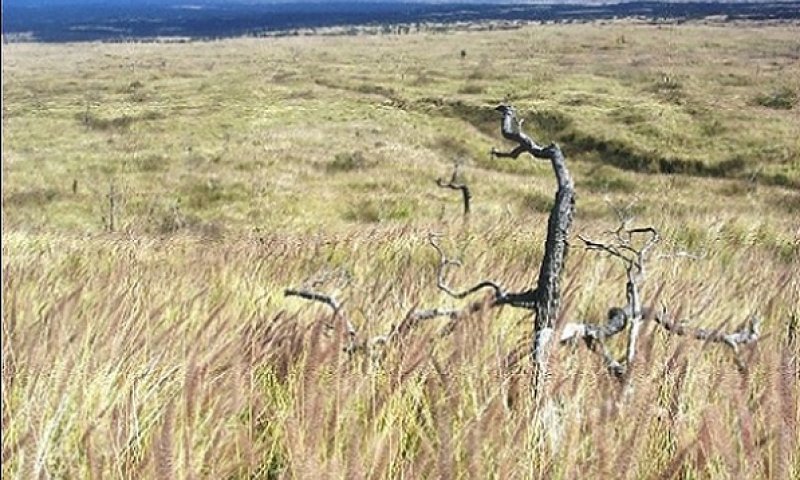
Figure 21. Former kauila forest a decade after fire. 4/18/07 D Clausnitzer MU150
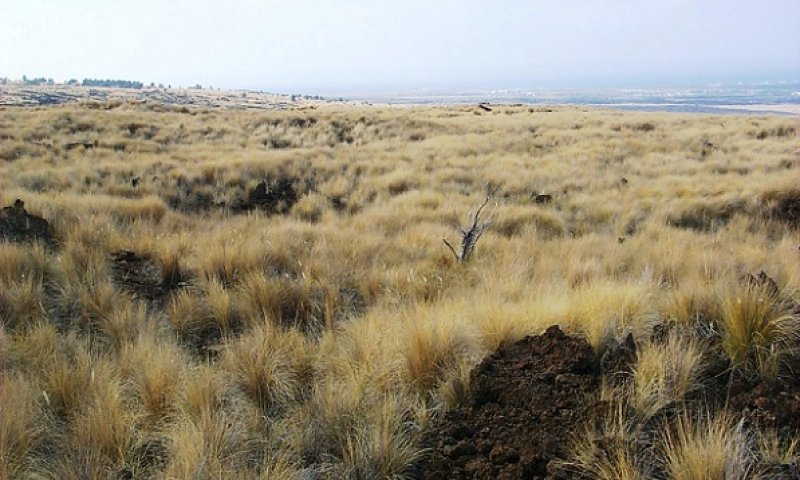
Figure 22. Fountaingrass. 1/20/06 D Clausnitzer generic photo
This community phase is dominated by an almost continuous cover of crimson fountaingrass (Pennisetum setaceum) up to 5 feet (1.5 meters) tall. Human-caused fires are frequent and result in a temporary growth of tree tobacco and castor bean that persists until the next fire. Tree tobacco serves as an alternative host for the endangered Blackburn’s Sphinx Moth (Manduca blackburni).
Forest overstory. There is little or no overstory in this community phase.
Forest understory. Crimson fountaingrass is by far the dominant species. Scattered individuals of other species occur, most commonly introduced lantana and tree tobacco (Nicotiana glauca) and native aalii (Dodonaea viscosa).
Figure 23. Annual production by plant type (representative values) or group (midpoint values)
Community 4.2
Crimson fountaingrass - Bermudagrass
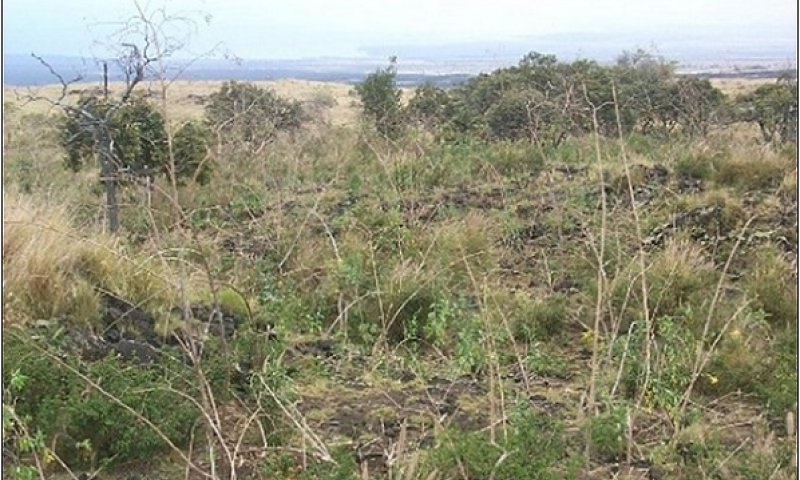
Figure 24. Weedy area on pahoehoe. 4/18/07 D Clausnitzer MU150
This community phase consists primarily of a combination of crimson fountaingrass and shortgrass species such as Bermudagrass. Weedy shrubs and forbs can be abundant. Tree and native plant regeneration is sparse to nonexistent due to wildfires and damage by ungulates.
Forest overstory. There is little or no overstory in this community phase.
Forest understory. Crimson fountaingrass, Bermudagrass, and Natal redtop (Melinis repens) are the most abundant grasses, in that order. Weedy shrubs and forbs can be abundant. Native plant regeneration is sparse to nonexistent due to heavy damage by ungulates. A diverse assemblage of weedy shrubs and forbs is found scattered through the grass stands. The most common shrubs are introduced lantana and tree tobacco (Nicotiana glauca) and native aalii (Dodonaea viscosa).
Table 14. Soil surface cover
| Tree basal cover | 0% |
|---|---|
| Shrub/vine/liana basal cover | 0% |
| Grass/grasslike basal cover | 25-30% |
| Forb basal cover | 0% |
| Non-vascular plants | 0% |
| Biological crusts | 0% |
| Litter | 65-75% |
| Surface fragments >0.25" and <=3" | 3-5% |
| Surface fragments >3" | 3-5% |
| Bedrock | 0% |
| Water | 0% |
| Bare ground | 5-10% |
Table 15. Woody ground cover
| Downed wood, fine-small (<0.40" diameter; 1-hour fuels) | – |
|---|---|
| Downed wood, fine-medium (0.40-0.99" diameter; 10-hour fuels) | – |
| Downed wood, fine-large (1.00-2.99" diameter; 100-hour fuels) | – |
| Downed wood, coarse-small (3.00-8.99" diameter; 1,000-hour fuels) | 1-3% |
| Downed wood, coarse-large (>9.00" diameter; 10,000-hour fuels) | – |
| Tree snags** (hard***) | – |
| Tree snags** (soft***) | – |
| Tree snag count** (hard***) | 0 per acre |
| Tree snag count** (hard***) | 0-1 per acre |
* Decomposition Classes: N - no or little integration with the soil surface; I - partial to nearly full integration with the soil surface.
** >10.16cm diameter at 1.3716m above ground and >1.8288m height--if less diameter OR height use applicable down wood type; for pinyon and juniper, use 0.3048m above ground.
*** Hard - tree is dead with most or all of bark intact; Soft - most of bark has sloughed off.
Pathway 4.1A
Community 4.1 to 4.2


Fountaingrass cover and vigor are reduced by continuous grazing. This allows shortgrass species such as Bermudagrass (Cynodon dactylon) to increase along with weedy shrubs and forbs.
Pathway 4.2A
Community 4.2 to 4.1


Fountaingrass cover and vigor is reduced by continuous grazing. This allows shortgrass species such as Bermudagrass (Cynodon dactylon) to invade the site, along with weedy shrubs and forbs.
Transition T1A
State 1 to 3
This state transitions to State 3 Invaded Savanna by domestic and feral ungulates consuming native plants and stripping bark from larger trees, and by trampling and breakage. Eventually the plant community will consist almost exclusively of mature trees, unpalatable native shrubs, introduced shrubs, and introduced forbs. In particular, crimson fountaingrass (Pennisetum setaceum) invades and dominates the understory.
Restoration pathway R2A
State 2 to 1
Restoration of this state to State 1 Reference is conceivably possible but would be difficult and expensive. Mechanical land clearing would be necessary, followed by intensive and long term weed control combined with native plant restoration.
Transition T2A
State 2 to 4
This state transitions to State 4 Invaded Grassland if sufficient understory biomass remains to carry a wildfire of sufficient intensity to kill the overstory trees.
Restoration pathway R3A
State 3 to 1
This state can be restored to State 1 Reference, particularly where dense native tree cover remains. The site must be securely fenced to exclude all domestic and feral ungulates, and a firebreak must be cleared around the fence line. Managed grazing outside the restoration site can help reduce wildfire threat. Introduced trees must be cut down, girdled, or killed with herbicide. Fountaingrass can be eliminated by weed whacking and then spraying the new leaves with herbicide; this usually must be done two or three times to kill most of the grass. Fountaingrass does not return easily to sites with fairly dense tree overstory (Susan Cordell, USFS-Hilo, personal communication). Some spontaneous native plant regeneration may occur. This usually is supplemented by replanting native species. Supplemental irrigation is very useful in the early stages of restoration.
Transition T3B
State 3 to 2
This state will gradually convert to State 2 Exotic Tree Invaded by invasion of competitive tree species, particularly silk oak and christmasberry. These introduced tree species are able to invade open glades as well as native tree stands, eventually outcompeting nearly all other vegetation. This process takes place when livestock grazing is halted or when fire frequency is low enough to permit trees to produce a dense canopy that reduces fine fuels.
Transition T3A
State 3 to 4
This state gradually transitions to State 4 Invaded Grassland due to lack of native plant regeneration due to weed competition and ungulate browsing coupled with destruction of existing native plants by ungulates. The transition is immediate when wildfire carried by abundant fountaingrass destroys all other vegetation. Fountaingrass stands recover quickly from fire.
Restoration pathway R4A
State 4 to 1
This state may be restored to a facsimile of State 1 Reference. The site must be securely fenced to exclude all domestic and feral ungulates, and a firebreak must be cleared around the fence line. Managed grazing outside the restoration site can help reduce wildfire threat. Introduced trees must be cut down, girdled, or killed with herbicide. Fountaingrass can be eliminated by weed whacking and then spraying the new leaves with herbicide; this usually must be done two or three times to kill most of the grass. Fountaingrass does not return easily to sites with fairly dense tree overstory (Susan Cordell, USFS-Hilo, personal communication). Some spontaneous native plant regeneration may occur. This usually is supplemented by replanting native species. Supplemental irrigation is very useful in the early stages of restoration.
Transition T4A
State 4 to 2
This state will transition gradually to State 2 Exotic Tree Invaded by invasion of competitive tree species, particularly silk oak and christmasberry. The rate of conversion will depend on proximity of tree seed sources. This process takes place when livestock are removed from a pasture or when fire frequency is low enough to permit trees to form a dense canopy that reduces fine fuels.
Additional community tables
Table 16. Community 1.1 forest overstory composition
| Common name | Symbol | Scientific name | Nativity | Height (ft) | Canopy cover (%) | Diameter (in) | Basal area (square ft/acre) |
|---|---|---|---|---|---|---|---|
|
Tree
|
|||||||
| lama | DISA10 | Diospyros sandwicensis | Native | 13–30 | 5–35 | 5–12 | – |
| 'ohi'a lehua | MEPO5 | Metrosideros polymorpha | Native | 20–60 | 20–25 | 5–16 | – |
| kauila | COOP | Colubrina oppositifolia | Native | 13–40 | 0–5 | 5–15 | – |
| mamani | SOCH | Sophora chrysophylla | Native | 13–25 | 0–5 | – | – |
| wili wili | ERSA11 | Erythrina sandwicensis | Native | – | 1–5 | 35– | – |
| Hawai'i brushholly | XYHA | Xylosma hawaiiensis | Native | 13–25 | 0–3 | – | – |
| mountain sandalwood | SAPA7 | Santalum paniculatum | Native | 13–20 | 0–2 | – | – |
| naio | MYSA | Myoporum sandwicense | Native | 13–30 | 0–1 | – | – |
| alpine sandmat | CHOL3 | Chamaesyce olowaluana | Native | 13–20 | 0–1 | – | – |
| 'ala'a | POSA11 | Pouteria sandwicensis | Native | 13–55 | 0–1 | 4–22 | – |
| Hawai'i hala pepe | PLHA4 | Pleomele hawaiiensis | Native | 13–20 | 0–1 | – | – |
| 'ohe makai | RESA | Reynoldsia sandwicensis | Native | 13–30 | 0–1 | – | – |
| Lanai colicwood | MYLA3 | Myrsine lanaiensis | Native | 13–25 | 0–1 | – | – |
| Hawai'i kauilatree | ALPO3 | Alphitonia ponderosa | Native | 13–30 | 0–0.5 | – | – |
| Kona cheesewood | PIHO | Pittosporum hosmeri | Native | 13–30 | 0–0.5 | – | – |
| Hawai'i roughbush | STPE3 | Streblus pendulinus | Native | 13–16 | 0–0.5 | – | – |
| mokihana kukae moa | MEHA4 | Melicope hawaiensis | Native | – | 0–0.1 | – | – |
| Hawai'i olive | NESA2 | Nestegis sandwicensis | Native | 13–20 | 0–0.1 | – | – |
| kawa'u | ZADI | Zanthoxylum dipetalum | Native | 13–25 | 0–0.1 | – | – |
| Hawai'i pricklyash | ZAHA | Zanthoxylum hawaiiense | Native | 13–20 | 0–0.1 | – | – |
| koa | ACKO | Acacia koa | Native | 13–25 | – | – | – |
| smallflower aiea | NOBR2 | Nothocestrum breviflorum | Native | 13–25 | – | – | – |
| ha'a | ANPL2 | Antidesma platyphyllum | Native | 13–20 | – | – | – |
| hame | ANPU2 | Antidesma pulvinatum | Native | 13–20 | – | – | – |
| forest gardenia | GABR | Gardenia brighamii | Native | 13–15 | – | – | – |
| uhiuhi | CAKA5 | Caesalpinia kavaiensis | Native | 13–20 | – | – | – |
| Hawai'i treecotton | KODR | Kokia drynarioides | Native | 13–20 | – | – | – |
| Brackenridge's rosemallow | HIBR | Hibiscus brackenridgei | Native | 13–20 | – | – | – |
| Hualalai hau kuahiwi | HIHU | Hibiscadelphus hualalaiensis | Native | 13–20 | – | – | – |
| Australasian catchbirdtree | PIBR3 | Pisonia brunoniana | Native | 13–25 | – | – | – |
| kopiko 'ula | PSHA3 | Psychotria hawaiiensis | Native | 13–20 | – | – | – |
| wingleaf soapberry | SASA4 | Sapindus saponaria | Native | 13–40 | – | – | – |
Table 17. Community 1.1 forest understory composition
| Common name | Symbol | Scientific name | Nativity | Height (ft) | Canopy cover (%) | |
|---|---|---|---|---|---|---|
|
Grass/grass-like (Graminoids)
|
||||||
| tanglehead | HECO10 | Heteropogon contortus | Native | 1–2 | 0–0.5 | |
| Pacific lovegrass | ERDE | Eragrostis deflexa | Native | 1–2 | 0–0.1 | |
| Hillebrand's flatsedge | CYHI | Cyperus hillebrandii | Native | 1–2 | 0–0.1 | |
|
Forb/Herb
|
||||||
| 'ena'ena | PSSA8 | Pseudognaphalium sandwicensium | Native | 0.5–1 | 0–0.5 | |
| Kaumahana | KOCO | Korthalsella complanata | Native | 0.5–1 | 0–0.1 | |
| smooth pricklypoppy | ARGL10 | Argemone glauca | Native | 1–2 | – | |
|
Fern/fern ally
|
||||||
| Boston swordfern | NEEX | Nephrolepis exaltata | Native | 0.5–2 | 0–0.5 | |
| black spleenwort | ASAD | Asplenium adiantum-nigrum | Native | 1–2 | 0–0.1 | |
| maidenhair spleenwort | ASTR2 | Asplenium trichomanes | Native | 0.5–1 | 0–0.1 | |
| dotted polypody | POPE5 | Polypodium pellucidum | Native | 0.5–2 | 0–0.1 | |
| Trans-Pecos cliffbrake | PETE2 | Pellaea ternifolia | Native | 0.5–1 | 0–0.1 | |
| whisk fern | PSNU | Psilotum nudum | Native | 0.5–1 | 0–0.1 | |
| weeping fern | LETH6 | Lepisorus thunbergianus | Native | 0.5–1 | 0–0.1 | |
|
Shrub/Subshrub
|
||||||
| Hawai'i hawthorn | OSAN | Osteomeles anthyllidifolia | Native | 2–8 | 1–10 | |
| Florida hopbush | DOVI | Dodonaea viscosa | Native | 2–6 | 1–5 | |
| Hawai'i rockwort | NOSA | Nototrichium sandwicense | Native | 2–8 | 0–1 | |
| Gaudichaud's senna | SEGA2 | Senna gaudichaudii | Native | 2–4 | 0–1 | |
| yellow ‘ilima | SIFA | Sida fallax | Native | 2–4 | 0–1 | |
| Maile | ALST11 | Alyxia stellata | Native | 0.5–4 | 0–1 | |
| alaweo | CHOA | Chenopodium oahuense | Native | 2–5 | 0–1 | |
| uhaloa | WAIN | Waltheria indica | Native | 1–2 | 0–0.5 | |
| variableleaf false ohelo | WISA | Wikstroemia sandwicensis | Native | 4–8 | 0–0.5 | |
| 'ekoko | CHCE | Chamaesyce celastroides | Native | 2–8 | 0–0.5 | |
| thorny popolo | SOIN | Solanum incompletum | Native | 2–5 | – | |
| ko'oloa 'ula | ABME2 | Abutilon menziesii | Native | 2–5 | – | |
| po'ola | CLSA | Claoxylon sandwicense | Native | 2–8 | – | |
| wild leadwort | PLZE | Plumbago zeylanica | Native | 2–4 | – | |
| Big Island ma'oloa | NEOV | Neraudia ovata | Native | 2–4 | – | |
| pukiawe | STTA | Styphelia tameiameiae | Native | 2–4 | – | |
|
Tree
|
||||||
| lama | DISA10 | Diospyros sandwicensis | Native | 2–13 | 0–10 | |
| mamani | SOCH | Sophora chrysophylla | Native | 2–13 | 0–3 | |
| 'ohi'a lehua | MEPO5 | Metrosideros polymorpha | Native | 2–13 | 0–1 | |
| mountain sandalwood | SAPA7 | Santalum paniculatum | Native | 5–13 | 0–0.5 | |
| Lanai colicwood | MYLA3 | Myrsine lanaiensis | Native | 2–13 | 0–0.5 | |
| naio | MYSA | Myoporum sandwicense | Native | 5–13 | 0–0.5 | |
| kauila | COOP | Colubrina oppositifolia | Native | 5–13 | 0–0.5 | |
| alpine sandmat | CHOL3 | Chamaesyce olowaluana | Native | 5–13 | 0–0.5 | |
| 'ala'a | POSA11 | Pouteria sandwicensis | Native | 5–13 | 0–0.1 | |
| Hawai'i olive | NESA2 | Nestegis sandwicensis | Native | 5–13 | 0–0.1 | |
| Hawai'i kauilatree | ALPO3 | Alphitonia ponderosa | Native | 5–13 | – | |
|
Vine/Liana
|
||||||
| Hualalai bur cucumber | SILA19 | Sicyos lasiocephalus | Native | 1–6 | 0–0.5 | |
| queen coralbead | COOR11 | Cocculus orbiculatus | Native | 1–4 | 0–0.5 | |
| oceanblue morning-glory | IPIN | Ipomoea indica | Native | 1–3 | 0–0.5 | |
| puakauhi | CAHA12 | Canavalia hawaiiensis | Native | 1–10 | 0–0.5 | |
| seabean | MUGI | Mucuna gigantea | Native | 2–10 | 0–0.1 | |
| Hawai'i lady's nightcap | BOME2 | Bonamia menziesii | Native | 1–2 | – | |
Table 18. Community 2.1 forest overstory composition
| Common name | Symbol | Scientific name | Nativity | Height (ft) | Canopy cover (%) | Diameter (in) | Basal area (square ft/acre) |
|---|---|---|---|---|---|---|---|
|
Tree
|
|||||||
| silkoak | GRRO | Grevillea robusta | Native | 40–70 | 85–90 | – | – |
| silkoak | GRRO | Grevillea robusta | Introduced | 13–40 | 0–1 | – | – |
| Brazilian peppertree | SCTE | Schinus terebinthifolius | Introduced | 13–16 | 0–1 | – | – |
Table 19. Community 2.1 forest understory composition
| Common name | Symbol | Scientific name | Nativity | Height (ft) | Canopy cover (%) | |
|---|---|---|---|---|---|---|
|
Grass/grass-like (Graminoids)
|
||||||
| basketgrass | OPHI | Oplismenus hirtellus | Introduced | 1–2 | 0–1 | |
|
Forb/Herb
|
||||||
| spreading snakeroot | AGRI2 | Ageratina riparia | Introduced | 1–2 | 0–1 | |
|
Shrub/Subshrub
|
||||||
| lantana | LACA2 | Lantana camara | Introduced | 2–5 | 0–1 | |
|
Tree
|
||||||
| Brazilian peppertree | SCTE | Schinus terebinthifolius | Introduced | 2–13 | 0–1 | |
| silkoak | GRRO | Grevillea robusta | Introduced | 2–13 | 0–0.5 | |
|
Vine/Liana
|
||||||
| Cape-ivy | DEOD | Delairea odorata | Introduced | 2–20 | 20–50 | |
Table 20. Community 3.1 plant community composition
| Group | Common name | Symbol | Scientific name | Annual production (lb/acre) | Foliar cover (%) | |
|---|---|---|---|---|---|---|
|
Grass/Grasslike
|
||||||
| 1 | Naturalized Grasses | 1750–2125 | ||||
| crimson fountaingrass | PESE3 | Pennisetum setaceum | 1750–2125 | – | ||
| Bermudagrass | CYDA | Cynodon dactylon | 25–125 | – | ||
| rose Natal grass | MERE9 | Melinis repens | 25–125 | – | ||
| kikuyugrass | PECL2 | Pennisetum clandestinum | 25–75 | – | ||
| cane bluestem | BOBA3 | Bothriochloa barbinodis | 0–75 | – | ||
| pitted beardgrass | BOPE2 | Bothriochloa pertusa | 0–25 | – | ||
| silver bluestem | BOSA | Bothriochloa saccharoides | 0–25 | – | ||
|
Forb
|
||||||
| 2 | Forbs | 25–75 | ||||
| perennial soybean | NEWI2 | Neonotonia wightii | 25–75 | – | ||
| oceanblue morning-glory | IPIN | Ipomoea indica | 0–50 | – | ||
| smooth pricklypoppy | ARGL10 | Argemone glauca | 0–50 | – | ||
| queen coralbead | COOR11 | Cocculus orbiculatus | 0–50 | – | ||
| petty spurge | EUPE6 | Euphorbia peplus | 0–25 | – | ||
|
Tree
|
||||||
| 3 | Trees and Shrubs | 250–500 | ||||
| silkoak | GRRO | Grevillea robusta | 125–250 | – | ||
| lama | DISA10 | Diospyros sandwicensis | 125–250 | – | ||
| lantana | LACA2 | Lantana camara | 125–250 | – | ||
| Hawai'i hawthorn | OSAN | Osteomeles anthyllidifolia | 75–200 | – | ||
| 'ohi'a lehua | MEPO5 | Metrosideros polymorpha | 75–200 | – | ||
| black poui | JAMI | Jacaranda mimosifolia | 75–200 | – | ||
| Brazilian peppertree | SCTE | Schinus terebinthifolius | 75–200 | – | ||
| Florida hopbush | DOVI | Dodonaea viscosa | 75–200 | – | ||
| wili wili | ERSA11 | Erythrina sandwicensis | 25–125 | – | ||
| comb bushmint | HYPE3 | Hyptis pectinata | 25–125 | – | ||
| yellow ‘ilima | SIFA | Sida fallax | 25–125 | – | ||
| pukiawe | STTA | Styphelia tameiameiae | 25–125 | – | ||
| Peruvian peppertree | SCMO | Schinus molle | 50–125 | – | ||
| Lanai colicwood | MYLA3 | Myrsine lanaiensis | 75–125 | – | ||
| mountain sandalwood | SAPA7 | Santalum paniculatum | 0–100 | – | ||
| castorbean | RICO3 | Ricinus communis | 25–75 | – | ||
| Hawai'i rockwort | NOSA | Nototrichium sandwicense | 0–75 | – | ||
| Barbary fig | OPFI | Opuntia ficus-indica | 0–75 | – | ||
| white leadtree | LELE10 | Leucaena leucocephala | 25–75 | – | ||
| anil de pasto | INSU | Indigofera suffruticosa | 25–75 | – | ||
| hairy Indian mallow | ABGR3 | Abutilon grandifolium | 25–75 | – | ||
| Mauritius hemp | FUFO | Furcraea foetida | 25–75 | – | ||
| 'ala'a | POSA11 | Pouteria sandwicensis | 0–50 | – | ||
| Hawai'i brushholly | XYHA | Xylosma hawaiiensis | 0–50 | – | ||
| mamani | SOCH | Sophora chrysophylla | 0–50 | – | ||
Table 21. Community 3.2 forest overstory composition
| Common name | Symbol | Scientific name | Nativity | Height (ft) | Canopy cover (%) | Diameter (in) | Basal area (square ft/acre) |
|---|---|---|---|---|---|---|---|
|
Tree
|
|||||||
| silkoak | GRRO | Grevillea robusta | Introduced | 13–50 | 5–10 | – | – |
| 'ohi'a lehua | MEPO5 | Metrosideros polymorpha | Native | 40–60 | 0–2 | – | – |
| 'ohi'a lehua | MEPO5 | Metrosideros polymorpha | Native | 13–40 | 1–2 | – | – |
| lama | DISA10 | Diospyros sandwicensis | Native | 13–25 | 0–2 | – | – |
| Brazilian peppertree | SCTE | Schinus terebinthifolius | Introduced | 13–20 | 1–2 | – | – |
| naio | MYSA | Myoporum sandwicense | Native | 13–25 | 0–1 | – | – |
| Lanai colicwood | MYLA3 | Myrsine lanaiensis | Native | 13–25 | 0–1 | – | – |
| black poui | JAMI | Jacaranda mimosifolia | Introduced | 13–35 | 0–1 | – | – |
| Peruvian peppertree | SCMO | Schinus molle | Introduced | 13–35 | 0–1 | – | – |
| mamani | SOCH | Sophora chrysophylla | Native | 13–20 | – | – | – |
Table 22. Community 3.2 forest understory composition
| Common name | Symbol | Scientific name | Nativity | Height (ft) | Canopy cover (%) | |
|---|---|---|---|---|---|---|
|
Grass/grass-like (Graminoids)
|
||||||
| crimson fountaingrass | PESE3 | Pennisetum setaceum | Introduced | 1–3 | 35–45 | |
| Bermudagrass | CYDA | Cynodon dactylon | Introduced | 0.2–0.5 | 15–25 | |
| rose Natal grass | MERE9 | Melinis repens | Introduced | 2–3 | 5–10 | |
| pitted beardgrass | BOPE2 | Bothriochloa pertusa | Introduced | 1–2 | 3–5 | |
| silver bluestem | BOSA | Bothriochloa saccharoides | Introduced | 1–2 | 0–1 | |
| cane bluestem | BOBA3 | Bothriochloa barbinodis | Introduced | 1–2 | 0–1 | |
|
Forb/Herb
|
||||||
| comb bushmint | HYPE3 | Hyptis pectinata | Introduced | 2–8 | 0.5–2 | |
| balloonplant | ASPH2 | Asclepias physocarpa | Introduced | 2–3 | 0.5–1 | |
| Peruvian groundcherry | PHPE4 | Physalis peruviana | Introduced | 2–4 | 0.5–1 | |
| Madagascar ragwort | SEMA15 | Senecio madagascariensis | Introduced | 0.5–1 | 0–1 | |
| lilac tasselflower | EMSO | Emilia sonchifolia | Introduced | 1–2 | 0–1 | |
| hairy beggarticks | BIPI | Bidens pilosa | Introduced | 1–2 | 0–1 | |
| spreading snakeroot | AGRI2 | Ageratina riparia | Introduced | 1–2 | 0–1 | |
| asthmaweed | COFL | Conyza floribunda | Introduced | 1–2 | 0–0.5 | |
| petty spurge | EUPE6 | Euphorbia peplus | Introduced | 1–2 | 0–0.5 | |
| balsampear | MOCH2 | Momordica charantia | Introduced | 1–2 | – | |
| cultivated tobacco | NITA | Nicotiana tabacum | Introduced | 2–3 | – | |
| common mullein | VETH | Verbascum thapsus | Introduced | 2–5 | – | |
| bull thistle | CIVU | Cirsium vulgare | Native | 2–3 | – | |
|
Shrub/Subshrub
|
||||||
| lantana | LACA2 | Lantana camara | Introduced | 2–4 | 5–15 | |
| hairy Indian mallow | ABGR3 | Abutilon grandifolium | Introduced | 2–3 | 1–2 | |
| castorbean | RICO3 | Ricinus communis | Introduced | 2–10 | 0–1 | |
| Florida hopbush | DOVI | Dodonaea viscosa | Native | 2–4 | 0.5–1 | |
| cure for all | PLCA10 | Pluchea carolinensis | Introduced | 2–4 | – | |
| Cape leadwort | PLAU6 | Plumbago auriculata | Introduced | 2–3 | – | |
| Mauritius hemp | FUFO | Furcraea foetida | Introduced | 5–7 | – | |
| Barbary fig | OPFI | Opuntia ficus-indica | Introduced | 2–5 | – | |
|
Tree
|
||||||
| tree tobacco | NIGL | Nicotiana glauca | Introduced | 2–10 | 0–1 | |
| lama | DISA10 | Diospyros sandwicensis | Native | 5–13 | 0–1 | |
| Lanai colicwood | MYLA3 | Myrsine lanaiensis | Native | 5–13 | 0–1 | |
| mamani | SOCH | Sophora chrysophylla | Native | 5–13 | 0–1 | |
| silkoak | GRRO | Grevillea robusta | Introduced | 2–13 | 0.5–1 | |
| black poui | JAMI | Jacaranda mimosifolia | Introduced | 2–13 | 0–1 | |
| Peruvian peppertree | SCMO | Schinus molle | Native | 2–13 | 0–0.1 | |
| Brazilian peppertree | SCTE | Schinus terebinthifolius | Introduced | 2–13 | 0–0.1 | |
| Cape cheesewood | PIVI5 | Pittosporum viridiflorum | Introduced | 2–4 | – | |
|
Vine/Liana
|
||||||
| fetid passionflower | PAFO2 | Passiflora foetida | Introduced | 1–4 | – | |
Table 23. Community 4.1 plant community composition
| Group | Common name | Symbol | Scientific name | Annual production (lb/acre) | Foliar cover (%) | |
|---|---|---|---|---|---|---|
|
Grass/Grasslike
|
||||||
| 1 | Naturalized Grasses | 1920–2160 | ||||
| crimson fountaingrass | PESE3 | Pennisetum setaceum | 1920–2160 | – | ||
| rose Natal grass | MERE9 | Melinis repens | 721–192 | – | ||
| Bermudagrass | CYDA | Cynodon dactylon | 48–144 | – | ||
| kikuyugrass | PECL2 | Pennisetum clandestinum | 72–120 | – | ||
| cane bluestem | BOBA3 | Bothriochloa barbinodis | 24–120 | – | ||
| silver bluestem | BOSA | Bothriochloa saccharoides | 24–72 | – | ||
| pitted beardgrass | BOPE2 | Bothriochloa pertusa | 24–48 | – | ||
|
Forb
|
||||||
| 2 | Native and Naturalized Forbs and Vines | 72–120 | ||||
| perennial soybean | NEWI2 | Neonotonia wightii | 24–96 | – | ||
| queen coralbead | COOR11 | Cocculus orbiculatus | 0–72 | – | ||
| oceanblue morning-glory | IPIN | Ipomoea indica | 0–72 | – | ||
|
Shrub/Vine
|
||||||
| 3 | Naturalized and Native Shrubs and Trees | 72–120 | ||||
| lantana | LACA2 | Lantana camara | 72–120 | – | ||
| Florida hopbush | DOVI | Dodonaea viscosa | 24–72 | – | ||
| comb bushmint | HYPE3 | Hyptis pectinata | 24–72 | – | ||
| tree tobacco | NIGL | Nicotiana glauca | 24–48 | – | ||
| castorbean | RICO3 | Ricinus communis | 0–48 | – | ||
| yellow ‘ilima | SIFA | Sida fallax | 0–24 | – | ||
| hairy Indian mallow | ABGR3 | Abutilon grandifolium | 0–24 | – | ||
Table 24. Community 4.2 forest understory composition
| Common name | Symbol | Scientific name | Nativity | Height (ft) | Canopy cover (%) | |
|---|---|---|---|---|---|---|
|
Grass/grass-like (Graminoids)
|
||||||
| crimson fountaingrass | PESE3 | Pennisetum setaceum | Introduced | 1–3 | 35–45 | |
| Bermudagrass | CYDA | Cynodon dactylon | Introduced | 0.2–0.5 | 15–25 | |
| rose Natal grass | MERE9 | Melinis repens | Introduced | 1–2 | 5–10 | |
| pitted beardgrass | BOPE2 | Bothriochloa pertusa | Introduced | 1–2 | 3–5 | |
| silver bluestem | BOSA | Bothriochloa saccharoides | Introduced | 1–2 | 0–1 | |
| cane bluestem | BOBA3 | Bothriochloa barbinodis | Introduced | 1–2 | 0–1 | |
|
Forb/Herb
|
||||||
| Madagascar ragwort | SEMA15 | Senecio madagascariensis | Introduced | 0.5–1 | 0–0.5 | |
| balsampear | MOCH2 | Momordica charantia | Introduced | 1–2 | – | |
| hairy beggarticks | BIPI | Bidens pilosa | Introduced | 1–2 | – | |
| cultivated tobacco | NITA | Nicotiana tabacum | Introduced | 2–3 | – | |
| common mullein | VETH | Verbascum thapsus | Introduced | 2–3 | – | |
| comb bushmint | HYPE3 | Hyptis pectinata | Introduced | 2–4 | – | |
| balloonplant | ASPH2 | Asclepias physocarpa | Introduced | 2–3 | – | |
|
Shrub/Subshrub
|
||||||
| lantana | LACA2 | Lantana camara | Introduced | 1–3 | 0–1 | |
| Florida hopbush | DOVI | Dodonaea viscosa | Native | 2–4 | 0–1 | |
| hairy Indian mallow | ABGR3 | Abutilon grandifolium | Introduced | 1–3 | – | |
| cure for all | PLCA10 | Pluchea carolinensis | Introduced | 1–3 | – | |
| Barbary fig | OPFI | Opuntia ficus-indica | Introduced | 4–5 | – | |
| Mauritius hemp | FUFO | Furcraea foetida | Introduced | 5–7 | – | |
| castorbean | RICO3 | Ricinus communis | Native | 2–4 | – | |
|
Tree
|
||||||
| tree tobacco | NIGL | Nicotiana glauca | Introduced | 2–10 | 0–1 | |
| silkoak | GRRO | Grevillea robusta | Introduced | 2–3 | – | |
Interpretations
Animal community
Native Wildlife
Community phases that provide open grassland or savanna-like settings provide habitat for the native Hawaiian hawk or io (Buteo solitarius) and Hawaiian owl or pueo (Asio flammeus spp. sandwichensis). Nene (Branta sandvicensis) are also found in this ecological site, particularly where fresh, green grass is available as food.
Introduced tree tobacco and rare native aiea (Nothocestrum breviflorum) trees provide food for caterpillars of the endangered Blackburn’s Sphinx Moth.
A large number of native bird species have gone extinct both before and after European contact.
Introduced Wildlife
This ecological site provides habitat to a variety of introduced birds. Species such as wild turkey (Meleagris gallopavo), ring-necked pheasant (Phasianus colchicus), Erckel’s francolin (Pternistis erckelii), chuckar partridge (Alectoris chukar), and black francolin (Francolinus francolinus) are considered to be game birds.
Feral pigs and sheep are common. They provide hunting opportunities but are very destructive to native vegetation. Public sport hunting typically does not have a major impact on their populations; exclusion by fences followed by intensive control measures are necessary to eliminate feral ungulates.
Introduced wildlife species are able to utilize all community phases within the ecological site.
Grazing Interpretations
The following table lists suggested initial stocking rates for cattle under the Forage Value Rating system for community phases 3.1 and 4.1. These are conservative estimates that should be used only as guidelines in the initial stages of the conservation planning process. Sometimes the current plant composition does not entirely match any particular plant community described in this ecological site description. Because of this, a field visit is recommended to document plant composition and production. More precise carrying capacity estimates should eventually be calculated using the following stocking rate information along with animal preference data, particularly when grazers other than cattle are involved. Under more intensive grazing management, improved harvest efficiencies may result in an increased stocking rate.
The naturalized plant community on this site is suitable for grazing by all kinds and classes of livestock, at any season, particularly cattle. However, this site is best utilized for mid-fall to late winter grazing as this is the major plant growth period. This site is suited for grazing by both cow-calf operations and stocker operations. However, sheep can be grazed on this site as well. This site is poorly suited to continuous year-long use if the naturalized plant community is to be maintained. This site does have restrictions and limitations. This site, in many instances, is surrounded by rough, bare lava flows. The access into the site, and handling of livestock thereafter can be difficult. As a result, roads or livestock trails would have to be constructed, and this could prove to be economically infeasible. The installation of livestock water developments may not prove practical for the same reasons. Herbaceous forage can be deficient in protein during the drier summer months.
Forage Value Rating (note 1)
Very High (note 2) 0.89-1.00 acre/AUM (note 3) 1.30-1.00 AUM/acre
High 1.00-1.25 acre/AUM 1.00-0.80 AUM/acre
Moderate 1.25–2.10 acre/AUM 0.80–0.60 AUM/acre
Low 2.10-+ acre/AUM 0.48-+ AUM/acre
(note 1) The Forage Value Rating System is not an ecological evaluation of the naturalized plant community. It is a utilitarian rating of the existing forage value of a specific tract of naturalized rangeland.
(note 2) Conservationists must use considerable judgment, because places in the Very High forage class could be producing less than normal volumes of forage, and adjustments would need to be made in the initial stocking rate.
(note 3) Stocking rates vary in accordance with such factors as kind and class of livestock or wildlife, season of use, and fluctuations in climate. Figures shown are calculated assuming a 30% adjustment factor to account for harvest efficiency and the “take half – leave half” principle. Actual use records and on-site inventories for individual rangeland ecological sites, together with a determination of the degree to which the sites have been grazed, offer the most reliable basis for developing initial stocking rates.
Hydrological functions
Hydrological functioning of this ecological site has probably been altered from its original state by the preponderance of area covered by fountaingrass. Rainfall interception and soil moisture transpiration are apparently higher with fountaingrass than with the original forest. Frequent fires in fountaingrass lay the soil bare, exposing it to wind and water erosion.
Recreational uses
The open aspect of this ecological site make it an excellent location for hiking, bird watching, hunting, and viewing the sharply contrasting lava flows. However, large areas of rough aa lava and dense fountaingrass make accessibility difficult.
Wood products
There are currently no wood products harvested commercially from this ecological site. Silk oak could be harvested. The sawdust of this tree causes dermatitis in some people (Little and Skolmen 1989).
Other products
None.
Other information
Definitions
These definitions have been greatly simplified for brevity and do not cover every aspect of each topic.
Aa lava: A type of basaltic lava having a rough, jagged, clinkery surface and a vesicular interior.
Alluvial: Materials or processes associated with transportation and/or deposition by running water.
Aquic soil moisture regime: A regime in which the soil is free of dissolved oxygen because it is saturated by water. This regime typically exists in bogs or swamps.
Aridic soil moisture regime: A regime in which defined parts of the soil are, in normal years, dry for more than half of the growing season and moist for less than 90 consecutive days during the growing season. In Hawaii it is associated with hot, dry areas with plants such as kiawe, wiliwili, and buffelgrass. The terms aridic and torric are basically the same.
Ash field: a land area covered by a thick or distinctive deposit of volcanic ash that can be traced to a specific source and has well defined boundaries. The term “ash flow” is erroneously used in the Physiographic section of this ESD due to a flaw in the national database.
Ashy: A “soil texture modifier” for volcanic ash soils having a water content at the crop wilting point of less than 30 percent; a soil that holds relatively less water than “medial” and “hydrous” soils.
Available water capacity: The amount of soil water available to plants to the depth of the first root-restricting layer.
Basal area or basal cover: The cross sectional area of the stem or stems of a plant or of all plants in a stand.
Blue rock: The dense, hard, massive lava that forms the inner core of an aa lava flow.
Bulk density: the weight of dry soil per unit of volume. Lower bulk density indicates a greater amount of pore space that can hold water and air in a soil.
CaCO3 equivalent: The amount of free lime in a soil. Free lime exists as solid material and typically occurs in regions with a dry climate.
Canopy cover: The percentage of ground covered by the vertical projection downward of the outermost perimeter of the spread of plant foliage. Small openings within the canopy are included.
Community pathway: A description of the causes of shifts between community phases. A community pathway is reversible and is attributable to succession, natural disturbances, short-term climatic variation, and facilitating practices, such as grazing management.
Community phase: A unique assemblage of plants and associated dynamic soil properties within a state.
Dominant species: Plant species or species groups that exert considerable influence upon a community due to size, abundance, or cover.
Drainage class: The frequency and duration of a water table in a soil. There are seven drainage classes, ranging from “excessively drained” (soils with very rare or very deep water tables) to “well drained” (soils that provide ample water for plant growth but are not so wet as to inhibit root growth) to “very poorly drained” (soils with a water table at or near the surface during much of the growing season that inhibits growth of most plants).
Electrical conductivity (EC): A measure of the salinity of a soil. The standard unit is deciSiemens per meter (dS/m), which is numerically equivalent to millimhos per centimeter (mmhos/cm). An EC greater than about 4 dS/m indicates a salinity level that is unfavorable to growth of most plants.
Friability: A soil consistency term pertaining to the ease of crumbling of soils.
Hydrous: A “soil texture modifier” for volcanic ash soils having a water content at the crop wilting point of 100 percent or more; a soil that holds more water than “medial” or “ashy” soils.
Ion exchange capacity: The ability of soil materials such as clay or organic matter to retain ions (which may be plant nutrients) and to release those ions for uptake by roots.
Isohyperthermic soil temperature regime: A regime in which mean annual soil temperature is 72 degrees F (22 degrees C) or higher and mean summer and mean winter soil temperatures differ by less than 11 degrees F (6 degrees C) at a specified depth.
Isomesic soil temperature regime: A regime in which mean annual soil temperature is 47 degrees F (8 degrees C) or higher but lower than 59 degrees F (15 degrees C) and mean summer and mean winter soil temperatures differ by less than 11 degrees F (6 degrees C) at a specified depth.
Isothermic soil temperature regime: A regime in which mean annual soil temperature is 59 degrees F (15 degrees C) or higher but lower than 72 degrees F (22 degrees C) and mean summer and mean winter soil temperatures differ by less than 11 degrees F (6 degrees C) at a specified depth.
Kipuka: An area of land surrounded by younger (more recent) lava. Soils and plant communities within a kipuka are older than, and often quite different from, those on the surrounding surfaces.
Major Land Resource Area (MLRA): A geographic area defined by NRCS that is characterized by a particular pattern of soils, climate, water resources, and land uses. The island of Hawaii contains nine MLRAs, some of which also occur on other islands in the state.
Makai: a Hawaiian word meaning “toward the sea.”
Mauka: a Hawaiian word meaning “toward the mountain” or “inland.”
Medial: A “soil texture modifier” for volcanic ash soils having a water content at the crop wilting point of 30 to 100 percent; a soil that holds an amount of water intermediate to “hydrous” or “ashy” soils.
Naturalized plant community: A community dominated by adapted, introduced species. It is a relatively stable community resulting from secondary succession after disturbance. Most grasslands in Hawaii are in this category.
Pahoehoe lava: A type of basaltic lava with a smooth, billowy, or rope-like surface and vesicular interior.
Parent material: Unconsolidated and chemically weathered material from which a soil is developed.
Perudic soil moisture regime: A very wet regime found where precipitation exceeds evapotranspiration in all months of normal years. On the island of Hawaii, this regime is found on top of Kohala and on parts of the windward side of Mauna Kea.
pH: The numerical expression of the relative acidity or alkalinity of a soil sample. A pH of 7 is neutral; a pH below 7 is acidic and a pH above 7 is basic.
Phosphorus adsorption: The ability of soil materials to tightly retain phosphorous ions, which are a plant nutrient. Some volcanic ash soils retain phosphorus so strongly that it is partly unavailable to plants.
Reference community phase: The phase exhibiting the characteristics of the reference state and containing the full complement of plant species that historically occupied the site. It is the community phase used to classify an ecological site.
Reference state: A state that describes the ecological potential and natural or historical range of variability of an ecological site.
Restoration pathway: A term describing the environmental conditions and practices that are required to recover a state that has undergone a transition.
Sodium adsorption ratio (SAR): A measure of the amount of dissolved sodium relative to calcium and magnesium in the soil water. SAR values higher than 13 create soil conditions unfavorable to most plants.
Soil moisture regime: A term referring to the presence or absence either of ground water or of water held at a tension of less than 1500 kPa (the crop wilting point) in the soil or in specific horizons during periods of the year.
Soil temperature regime: A defined class based on mean annual soil temperature and on differences between summer and winter temperatures at a specified depth.
Soil reaction: Numerical expression in pH units of the relative acidity or alkalinity or a soil.
State: One or more community phases and their soil properties that interact with the abiotic and biotic environment to produce persistent functional and structural attributes associated with a characteristic range of variability.
State-and-transition model: A method used to display information about relationships between vegetation, soil, animals, hydrology, disturbances, and management actions on an ecological site.
Torric soil moisture regime: See Aridic soil moisture regime.
Transition: A term describing the biotic or abiotic variables or events that contribute to loss of state resilience and result in shifts between states.
Udic soil moisture regime: A regime in which the soil is not dry in any part for as long as 90 cumulative days in normal years, and so provides ample moisture for plants. In Hawaii it is associated with forests in which hapuu (tree ferns) are usually moderately to highly abundant.
Ustic soil moisture regime: A regime in which moisture is limited but present at a time when conditions are suitable for plant growth. In Hawaii it usually is associated with dry forests and subalpine shrublands.
Supporting information
Type locality
| Location 1: Hawaii County, HI | |
|---|---|
| Latitude | 19° 46′ 6″ |
| Longitude | 155° 56′ 20″ |
| General legal description | Protected by fence and manager. Overstory is dominated by lama. |
| Location 2: Hawaii County, HI | |
| Latitude | 19° 46′ 9″ |
| Longitude | 155° 56′ 23″ |
| General legal description | Site is protected by fence. Overstory is dominated by ohia lehua. |
| Location 3: Hawaii County, HI | |
| Latitude | 19° 46′ 5″ |
| Longitude | 155° 56′ 5″ |
| General legal description | Site is protected by fence. Overstory contains diverse species. |
Other references
Armstrong RW. 1973. Atlas of Hawaii. University of Hawai`i Press, Honolulu.
Athens JS. Ch. 12 Hawaiian Native Lowland Vegetation in Prehistory in Historical Ecology in the Pacific Islands – Prehistoric Environmental and Landscape Change. Kirch PV and TL Hunt, eds. 1997. Yale U. Press, New Haven.
Burney DA, HF James, LP Burney, SL Olson, W Kikuchi, WL Wagner, M Burney, D McCloskey, D Kikuchi, FV Grady, R Gage II, and R Nishek. 2001. Fossil evidence for a diverse biota from Kauai and tis transformation since human arrival. Ecological Monographs 71:615-641.
Christensen CC. 1983. Report 17: Analysis of land snails. In Archaeological investigations of the Mudlane-Waimea-Kawaihae Road Corridor, Island of Hawaii: an Interdisciplinary Study of an Environmental Transect. Clark JT and Kirch PV, eds. Dept. of Anthropology, Bernice Pauahi Bishop Museum, Report 83-1, Honolulu, HI.
Clark JT. 1983. Report 3: The Waimea-Kawaihae Region: Historical Background. In Archaeological investigations of the Mudlane-Waimea-Kawaihae Road Corridor, Island of Hawaii: an Interdisciplinary Study of an Environmental Transect. Clark JT and Kirch PV, eds. Dept. of Anthropology, Bernice Pauahi Bishop Museum, Report 83-1, Honolulu, HI.
Clark JT. 1983. Report 7: Archaeological investigations in Section 4. In Archaeological investigations of the Mudlane-Waimea-Kawaihae Road Corridor, Island of Hawaii: an Interdisciplinary Study of an Environmental Transect. Clark JT and Kirch PV, eds. Dept. of Anthropology, Bernice Pauahi Bishop Museum, Report 83-1, Honolulu, HI.
Clark JT. 1983. Report 8: Archaeological investigations of agricultural sites in the Waimea area. In Archaeological investigations of the Mudlane-Waimea-Kawaihae Road Corridor, Island of Hawaii: an Interdisciplinary Study of an Environmental Transect. Clark JT and Kirch PV, eds. Dept. of Anthropology, Bernice Pauahi Bishop Museum, Report 83-1, Honolulu, HI.
Craighill ES and EG Handy. 1991. Native Planters in Old Hawaii – Their Life, Lore, and Environment. Bernice P. Bishop Museum Bulletin 233, Bishop Museum Press, Honolulu, HI
Cuddihy LW and CP Stone. 1990. Alteration of Native Hawaiian Vegetation: Effects of Humans, Their Activities and Introductions. Honolulu: University of Hawaii Cooperative National Park Resources Study Unit.
Hazlett RW and DW Hyndman. 1996. Roadside Geology of Hawaii. Mountain Press Publishing Company, Missoula MT.
Henke LA. 1929. A Survey of Livestock in Hawaii. Research Publication No. 5. University of Hawaii, Honolulu.
Horrocks M. 2009. Sweet potato (Ipomoea batatas) and banana (Musa sp.) microfossils in deposits from the Kona Field System, Island of Hawaii. Journal of Archaeological Science, May 2009.
Kirch PV. 1982. The impact of the prehistoric Polynesians in the Hawaiian ecosystem. Pacific Science 36(1):1-14.
Kirch PV. 1983. Introduction. In Archaeological investigations of the Mudlane-Waimea-Kawaihae Road Corridor, Island of Hawaii: an Interdisciplinary Study of an Environmental Transect. Clark JT and Kirch PV, eds. Dept. of Anthropology, Bernice Pauahi Bishop Museum, Report 83-1, Honolulu, HI.
Kirch PV. 1985. Feathered Gods and Fishhooks: An Introduction to Hawaiian Archaeology and Prehistory. Honolulu: University of Hawaii Press.
Kirch PV. 2000. On the Road of the Winds: An Archaeological History of the Pacific Islands Before European Contact. Berkeley: University of California Press.
Little EL Jr. and RG Skolmen. 1989. Common Forest Trees of Hawaii (Native and Introduced). US Department of Agriculture-US Forest Service Agriculture Handbook No. 679. (out of print). Available at www.fs.fed.us/psw/publications/documents/misc/ah679.pdf
Maly K and O Maly. 2004. He Moolelo Aina: A Cultural Study of the Puu O Umi Natural Area Reserve and Kohala-Hamakua Mountain Lands, Districts of Kohala and Hamakua, Island of Hawaii. Kumu Pono Associates, Hilo HI.
McEldowney H. 1983. Report 16: A description of major vegetation patterns in the Waimea-Kawaihae region during the early historic period. Archaeological investigations of the Mudlane-Waimea-Kawaihae Road Corridor, Island of Hawaii: an Interdisciplinary Study of an Environmental Transect. Clark JT and Kirch PV, eds. Dept. of Anthropology, Bernice Pauahi Bishop Museum, Report 83-1, Honolulu, HI.
Mueller-Dombois D and FR Fosberg. 1998. Vegetation of the Tropical Pacific Islands. Springer-Verlag New York, Inc.
Palmer DD. 2003. Hawaii’s Ferns and Fern Allies. University of Hawaii Press, Honolulu.
Pratt HD. 1998. A Pocket Guide to Hawaii’s Trees and Shrubs. Mutual Publishing, Honolulu.
Ripperton JC and EY Hosaka. 1942. Vegetation zones of Hawaii. Hawaii Agricultural Experiment Station Bulletin 89:1-60.
Rock JF. The Indigenous Trees of the Hawaiian Islands. 1st edition 1913, reprinted 1974, Charles E. Tuttle Company, Rutland, VT and Tokyo, Japan.
Shoji SD, M Nanzyo, and R Dahlgren. 1993. Volcanic Ash Soils: Genesis, Properties and Utilization. Elsevier, New York.
Sohmer SH and R Gustafson. 2000. Plants and Flowers of Hawaii. University of Hawaii Press, Honolulu.
Steadman DW. 1995. Prehistoric extinctions of Pacific island birds: biodiversity meets zooarchaeology. Science 267:1123-1131.
USDA-NRCS-PIA T&E Species GIS files. Not publicly available.
USDI-USGS. 2006. A GAP Analysis of Hawaii. Final Report and Data.
Vitousek P. 2004. Nutrient Cycling and Limitation: Hawaii as a Model Ecosystem. Princeton University Press, Princeton and Oxford.
Wagner WL, DR Herbst, and SH Sohmer. 199. Manual of the Flowering Plants of Hawai`i, Revised Edition. Bishop Museum Press, Honolulu.
Welch DJ 1983. Report 5: Archaeological investigations in Section 2. In Archaeological investigations of the Mudlane-Waimea-Kawaihae Road Corridor, Island of Hawaii: an Interdisciplinary Study of an Environmental Transect. Clark JT and Kirch PV, eds. Dept. of Anthropology, Bernice Pauahi Bishop Museum, Report 83-1, Honolulu, HI.
Whistler WA. 1995. Wayside Plants of the Islands: a Guide to the Lowland Flora of the Pacific Islands. Isle Botanica, Honolulu.
Contributors
David Clausnitzer
Loretta Metz
Joseph May
Acknowledgments
Assistance, advice, review, and/or insights:
Mick Castillo
Michael Constantinides, NRCS-PIA
Susan Cordell, USFS
Gordon Cran, Kapapala Ranch
Mike Donohoe
David Leonard, volunteer
JB Friday, UH Forestry Extension
Rick Gordon
Basil Hansen, The Nature Conservancy
Jennifer Higashino, USFWS and NRCS
Flint Hughes, USFS
Chris Jasper, NRCS Soil Survey
Mel Johansen, The Nature Conservancy
Kathy Kawakami, US Army Pohakuloa Training Ground
Rhonda Loh, Volcanoes National Park
Kamehameha Schools/Bishop Estate
Miles Nakahara, Hawaii DOFAW
Laura Nelson, The Nature Conservancy and NRCS
Patrick Niemeyer, NRCS Soil Survey
Billy Paris, rancher
John Pipan
Jon Price, USGS
John Replogle, The Nature Conservancy
Paul Scowcroft, USFS
Earl Spence, grazing consultant
Jim Thain
Mike Tomich
Quentin Tomich
Tim Tunison, Volcanoes National Park
Jill Wagner, consultant, Future Forests
Rick Warschauer
Rangeland health reference sheet
Interpreting Indicators of Rangeland Health is a qualitative assessment protocol used to determine ecosystem condition based on benchmark characteristics described in the Reference Sheet. A suite of 17 (or more) indicators are typically considered in an assessment. The ecological site(s) representative of an assessment location must be known prior to applying the protocol and must be verified based on soils and climate. Current plant community cannot be used to identify the ecological site.
| Author(s)/participant(s) | |
|---|---|
| Contact for lead author | |
| Date | |
| Approved by | |
| Approval date | |
| Composition (Indicators 10 and 12) based on | Annual Production |
Indicators
-
Number and extent of rills:
-
Presence of water flow patterns:
-
Number and height of erosional pedestals or terracettes:
-
Bare ground from Ecological Site Description or other studies (rock, litter, lichen, moss, plant canopy are not bare ground):
-
Number of gullies and erosion associated with gullies:
-
Extent of wind scoured, blowouts and/or depositional areas:
-
Amount of litter movement (describe size and distance expected to travel):
-
Soil surface (top few mm) resistance to erosion (stability values are averages - most sites will show a range of values):
-
Soil surface structure and SOM content (include type of structure and A-horizon color and thickness):
-
Effect of community phase composition (relative proportion of different functional groups) and spatial distribution on infiltration and runoff:
-
Presence and thickness of compaction layer (usually none; describe soil profile features which may be mistaken for compaction on this site):
-
Functional/Structural Groups (list in order of descending dominance by above-ground annual-production or live foliar cover using symbols: >>, >, = to indicate much greater than, greater than, and equal to):
Dominant:
Sub-dominant:
Other:
Additional:
-
Amount of plant mortality and decadence (include which functional groups are expected to show mortality or decadence):
-
Average percent litter cover (%) and depth ( in):
-
Expected annual annual-production (this is TOTAL above-ground annual-production, not just forage annual-production):
-
Potential invasive (including noxious) species (native and non-native). List species which BOTH characterize degraded states and have the potential to become a dominant or co-dominant species on the ecological site if their future establishment and growth is not actively controlled by management interventions. Species that become dominant for only one to several years (e.g., short-term response to drought or wildfire) are not invasive plants. Note that unlike other indicators, we are describing what is NOT expected in the reference state for the ecological site:
-
Perennial plant reproductive capability:
Print Options
Sections
Font
Other
The Ecosystem Dynamics Interpretive Tool is an information system framework developed by the USDA-ARS Jornada Experimental Range, USDA Natural Resources Conservation Service, and New Mexico State University.
Click on box and path labels to scroll to the respective text.